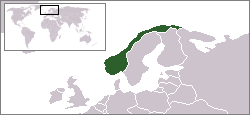Norway
Norway (Norwegian: Norge or Noreg) is the westernmost, northernmost — and surprisingly also the easternmost — of the three Scandinavian countries. Norway is known for the complex and deep fjords along its west coast, as well as the midnight sun and Northern Lights. Mainland Norway stretches from the North Sea near Denmark and Scotland to borders with northern Finland and the northwestern tip of Russia, and has a long border with Sweden to the east. Norway also includes the Svalbard islands in the Arctic.
Regions
| East Norway (Akershus, Buskerud, Hedmark, Oppland, Oslo, Østfold, Telemark, Vestfold) Østlandet, including the low southeast region surrounding the capital Oslo, the most densely populated area in Norway with the majority of people living here |
| Trøndelag Middle Norway, mostly known as Trøndelag, with the ancient city of Trondheim |
| Northern Norway (Finnmark, Troms, Nordland) Great fjords, the midnight sun and the ancient Sami culture – 50% of Norway's area and 10% of its people |
| Agder Also called Sørlandet or South Norway, with the gentle coastline |
| West Norway (Møre og Romsdal, Sogn og Fjordane, Hordaland, Rogaland) Vestlandet, with the famous fjords and Bergen |
| Svalbard An archipelago in the Barents Sea north of Norway, famous for its harsh climate, coal mines and satellite installations. Except for northeasternmost European Russia this is the only part of Europe where polar bears live. |
| Jan Mayen A desolate, mountainous and volcanic island in the Arctic Ocean, partially covered in glaciers with some moss and grass. Military area, admittance only with special permission. Not accessible during winter months. |
Cities
- 🌍 Oslo – the capital and largest city of Norway, with museums of national importance, a beautiful setting and lively nightlife and cultural scene.
- 🌍 Bergen – Once the capital of Norway, old Hanseatic trading centre with a rich culture and dramatic scenery, Norway's second largest city. Wonderfully cute wooden buildings, a magnificent mountain setting, varied nightlife and lots of atmosphere. This is your gateway to the western fjords. The city has been dubbed "the rainiest city in Europe" with an average of 250 days of rainfall a year. Bring an umbrella.
- 🌍 Bodø – The gateway to the magnificent Lofoten islands. And the place of Saltstraumen, the worlds strongest maelstrom.
- 🌍 Drammen – Once known as industrial and grimy, but refurbishment has made Drammen an enjoyable side trip from Oslo.
- 🌍 Fredrikstad – A magnificent old town stands out from the rest of the rather nondescript city. Brilliant as a day trip from Oslo.
- 🌍 Kristiansand – The jolly capital of the South. Best known for the family attraction Kristiansand zoo and amusement park and as Norway's "cool riviera".
- 🌍 Stavanger – The fourth largest city, and the third largest urban area. Commercially important due to the oil business. The wooden, cobbled central area is one of the most charming places in Norway. Home to one of Norway's medieval churches, you can also visit Iron Age homes, stone age caves, and sites where the Viking kings used to meet at Ullandhaugtårnet. Stavanger is where Erik the Red was born.
- 🌍 Tromsø – A magnificent, modern cathedral and absolutely no polar bears roaming the streets.
- 🌍 Trondheim – Famous for its stunning cathedral (Nidarosdomen). Wonderful riverside wharfs, wooden buildings and the best student nightlife in Norway give beautiful, leafy Trondheim its charm.
Other destinations
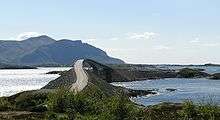
- 🌍 Atlanterhavsveien – The Atlantic Ocean Road is a spectacular road with bridges along islands and skerries on the edge of the Atlantic Ocean.
- 🌍 Hardangervidda – Norway's largest national park on a large highland plateau.
- 🌍 Jostedalsbreen – The largest glacier on the European mainland.
- 🌍 Jotunheimen – A majestic landscape and home of Norway's highest mountains.
- 🌍 Lofoten – Experience the midnight sun in this traditional fishing district in the northern province with islands and mountains.
- 🌍 Nordkapp – This cliff is the northernmost point of continental Europe, overlooking the Barents ocean.
- 🌍 Sognefjorden – Glaciers, mountains and picturesque settlements are but a few of the sights on the Sognefjord. Flåm and Nærøyfjorden (also a UNESCO World Heritage site) are parts of the mighty Sognefjorden system.
Understand
_in_Oldedalen%2C_2011_August.jpg)
The overall impression of Norway is a country with ample space and unusually rugged landscape. While famous for the great fjords along the Atlantic, also the interior has great valleys, wide forests and fjord-like lakes. Norway is one of the most mountainous countries in Europe. Water in all varieties is perhaps what characterizes Norway most: The endless coastline, the great fjords, countless waterfalls, crystal rivers, lovely lakes and numerous glaciers.
Although the great outdoors is Norway's number 1 attraction, there are also many interesting and lively cities like Oslo and Bergen. Man-made attractions include Norway's cultural heritage as well as modern structures and architecture - often found in cities but also in terms of impressive engineering in remote corners.
History
- See also: Vikings and the Old Norse, Nordic history
The petty Viking kingdoms of Norway were unified in 872 AD by Harald Fairhair. In the following period, Norwegians settled in many places, such as Iceland, the Faroe Islands and parts of Scotland and Ireland, where they founded Dublin and Waterford. In the beginning of the 14th century, Norway and Sweden were unified as the Norwegian king was also elected king of Sweden. At the end of the century, the two countries and Denmark were unified in the so-called Kalmar Union.
Sweden broke out of the union in 1521. Norway remained in union with Denmark until the Napoleonic Wars of 1814. Only a few months after Norway declared independence, Sweden invaded Norway and enforced a personal union, though Norway had a great deal of independence.
The union with Sweden lasted until 1905, which is considered the beginning of modern Norway. Norway have later rejected membership in the European Union, arguing that "we just left a union". From 1940 until 1945, Norway was occupied by German forces during World War 2. In the 1960s, oil was found in the North Sea. Oil drilling has brought Norway prosperity, but contrary to many other oil-exporting countries, Norway invests its profits in a very egalitarian and collectivist way creating an affluent, harmonious society taking advantage of excellent infrastructure and pioneering environmentally friendly technologies in everyday lives. Repeatedly ranked as a country with one of the world's highest standards of living, Norway has attracted migrants from many places all over the world, which add to today's colourful and inclusive society. All this does not come cheap, and consumer prices are among the highest in the world.
Geography
- I design coastlines. I got an award for Norway. – The Hitchhiker's Guide to the Galaxy, Douglas Adams
.jpg)
Norway sits on a large peninsula shared with Sweden in the north of Europe. In the north, it also borders Finland and Russia. Some 5 million inhabitants share an area about the size of Germany and larger than Britain. Norway is primarily a very long country - driving from the most southern to the most northern cities equals the distance from Hamburg to Malaga (and through much more rugged terrain). Norway's coastline is also one of the longest in the world - if islands and fjords are included the coastline has been calculated as 50,000 to 100,000km. Nordland county alone has a longer coastline than the entire United Kingdom when fjords and islands are included.
Norway is well known for its amazing and varied scenery. The famous fjords are long narrow inlets of the ocean, flanked on either side by tall mountains where the sea penetrates far inland. Norway's endless coastline also includes countless islands of all sizes - there are more than 200,000 identified islands along Norway's coast (only surpassed by Greece). The many islands and skerries shelter the coast from the rough Atlantic such that Hurtigruten and other ships can travel long stretches on calm waters. These sheltered (internal) waters (fjords, bays and straits) covers some 100,000km2.
There are more than 450,000 lakes throughout Norway well over 100,000 of these are in Finnmark county; even inside the city of Oslo there are several hundred lakes. Norway is home to the deepest lakes in Europe. Lakes and rivers cover more than 5 % of the land. The vast majority of the land (about 95 %) is rocky wilderness and forests, and thus Norway has large, completely unpopulated areas, many of which have been protected as national parks. Also outside the national parks, much of the land is largely unspoiled nature - there is in fact no need to visit a national park to experience wilderness and great landscapes. Roads and railways as well as ordinary ferries offer easy access to great panoramas. There are few sandy beaches along Norway's endless shores; shores are typically rocky, steep cliffs or smooth polished slabs of rock.
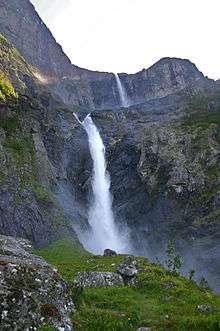
Norway's highest point is Galdhøpiggen, 2,469m (8,100 ft) in the Jotunheimen region that lies midway between Oslo and Trondheim, but away from the coast. In the far north (Finnmark), there are relatively flat open spaces. Several of the world's tallest waterfalls are in Norway, particularly in the western fjords and the mountain region. While there are mountains all over Norway, some major mountain areas define Norway's main regions. The north-south line of mountain areas (notably Hardangervidda and Jotunheimen) are major barriers and separate West Norway from East Norway. Similarly the wide Dovrefjell separates Middle Norway (Trøndelag) from East Norway. Norway also includes the nearly unpopulated Svalbard archipelago far from the mainland, on the edge of the arctic ice shelf.
The long rugged coast, fjords, countless lakes, tall waterfalls and pretty rivers means that water is the one thing that most characterizes Norway. Norway's mainland has more than 2000 glaciers that covers almost 1 % of the land. Jostedalsbreen occupies about 500 km2 and is the largest glacier in mainland Europe. Svalbard is covered by 60 % glaciers and has the largest glacier in Europe - only matched by Vatnajökull in Iceland. Glaciers are most common in Hardanger, Sogn og Fjordane/Jotunheimen, Nordland and Lyngen.
Administratively, Norway is divided into counties that are grouped into regions East, South, West, middle (Trøndelag) and North. The landscape of Norway can also be described by zones that cuts across these administrative divisions.
- The "fjordland", the part of Norway dominated by fjords, runs as a wide belt all along the country, 20 to 200km wide. This particular landscape is typically a tangle of fjords and peninsulas, valleys and lakes.
- Island belt, Further out the mainland is sheltered by a belt of islands and skerries, this belt is often wide and complex for instance around Bergen or the Lofoten archipelago. Such belt of islands allows ships safe journey along major parts of the coast. Just south of Stavanger there are neither fjords nor islands, leaving the long sandy beaches unprotected.
- Mountain region: Somewhat inland and partly coinciding with fjords is the high mountain belt running basically South-North through the entire Scandinavian peninsula separating East Norway and West Norway, while further north separating Norway and Sweden. The high mountains vary from wild alpine summits and glaciers towards the Atlantic and more mellow landscapes further east. The mountain landscapes include barren plateaus (vidde) such as Hardangervidda in the south and Finnmarksvidda modest elevation in the north.
- Big valleys: East/South of the central mountains are the land of big valleys that stretch from the lowlands around Oslo to the central mountains. Gudbrandsdal, Hallingdal, Setesdal and Valdres are typical big valleys. In eastern and central Finnmark the fjords instead of high mountains changes into a wide plateau at moderate altitude.
- Central eastern lowland: Greater Oslo, both shores of the Oslofjord (Vestfold and Østfold counties), and around big lakes Mjøsa and Tyrifjorden is the most densely populated and most important agricultural area.
Nature and wildlife
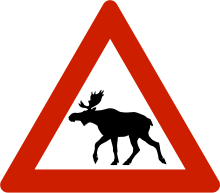
Norway's wild animals are rarely seen during a brief visit. In Norway's wide forests there are several hundred thousand moose (elk, Norwegian elg) and some 40,000 are hunted every year. Most of the European moose are in the Norway, Finland and Sweden. Visitors may spot these large animals along roads at dusk and dawn, occasionally they stroll onto the highway causing traffic hazard. In West Norway there is an equally large number of red deere (Norwegian: hjort). The red deere is somewhat more watchful and careful than the moose, but can in some areas be seen in large numbers grazing meadows in spring and autumn. There is a small group of musk ox in the Dovre plateau, this animal does run away but forms a defense and can attack if approached. In the high plateaus like Hardangervidda and Rondane there are large reindeer flocks as well as smaller groups of young males roaming on their own. Reindeer are only occasionally seen from roads, usually several days of hiking is needed to spot this high mountain animal. In Northern Norway reindeer is semi-domesticated and privately owned, these are often seen along roads and close to settlements.
There is a moderate number of brown bear, wolverine and lynx. These predators are very watchful and are rarely observed even by locals. Wild animals are generally protected and should not be disturbed.
The most intense wildlife is found along Norway's endless coast notably the several million sea birds, sea animals and fish. The harbour porpoise is common and can occasionally be seen in fjords. Killer whales (orcas) are common and hunt herring along the Norwegian coast particularly in Nordland and Troms. Previously dolphins were rarely seen in Norway, since about year 2000 dolphins visit the Oslofjord, the Agder coast as well as the West coast. The puffin (Norwegian: lunde) exist in large numbers (possibly more than 1 million) at some locations in Western and Northern Norway. The bird cliffs at Runde island is home to several hundred thousand puffins. In Nordland county, there are more than thousand sea eagles (white-tailed eagle), the greatest density of this large bird in Europe.
People
Norway is one of Europe's most sparsely populated countries. With a population of only 5 million people and a land area of 385,802km2, the population density is only 16 inhabitants per km2. Most of the population are Norwegians. The indigenous Sami people traditionally inhabit the northern part of Norway, that along with parts of Sweden, Finland and Russia outlines an area known as Sapmi (or Sameland). Other recognized minorities are the Kven people, Jews, Forest Finns, and Norwegian Romani Travellers. In recent years, immigration, in particular from the European Union, has increased greatly.
Norway is formally a Christian country with a dominant Lutheran majority of around 80%; however, many Norwegians do not attend church.
Norway has become rather liberal in moral issues and thus more similar to southern neighbours like Denmark and the Netherlands. Homosexuality is accepted by most people and in 2008 same-sex marriage was given the same legal status as traditional marriage. For instance, a previous male minister of finance and prominent figure in the conservative party is in partnership with a prominent male business manager. With that said, some parts along the southern and southwestern coast are fairly conservative, especially in the more rural areas.
Although crime is low, Norwegians like locking things away - in cities you will even see communal washing lines for drying clothes surrounded by a chain-link fence and a padlock to which all the entitled tenants have access.
Economy and politics
Norway's primary source of income is the North Sea oil and gas industry, which makes up more than 20 per cent of its GDP. It also has several other natural resources such as hydro-electric power, wood, fish and minerals, some manufacturing, and a healthy technology sector. Politically, it is dominated by a widespread and continued support for the Scandinavian model, which means high taxes and high government spending to support free schools, free healthcare, an efficient welfare system and many other benefits. The unemployment rate in Norway is about 4.5 percent.
Norwegians rejected EU membership, in referendums held 1972 and 1994, both times just by a few percentage points. France vetoed Norwegian EU membership in the 1950s and 1960s. However, being a member state of the European Economic Area and part of the Schengen agreement, Norway is closely harmonised with the EU, and integrated as a full member in most economic matters, as well as in customs and immigration matters. This is of great economic importance to Norway.
As one of the richest countries in the world and with a strong currency, most visitors should expect higher prices than at home. In addition, Norway has a very compressed wage structure which means that even typically low skilled work is relatively well paid. For the same reason, firms try to keep the number of staff as low as possible, even for low-skilled service staff. On the other hand, many attractions in Norway are free of charge, most notably the landscape and nature itself. Furthermore, you don't have to spend much money on accommodation if you're prepared to sleep in a tent or under the open sky. According to the Norwegian right to access, you may stay for up to two nights in one spot in uncultivated land if you keep away from houses and other buildings and out of the way of other people, provided that you leave no trace. If you move far away from people, you can stay for as long as you want.
Climate
- See also:Winter in the Nordic countries and Winter driving
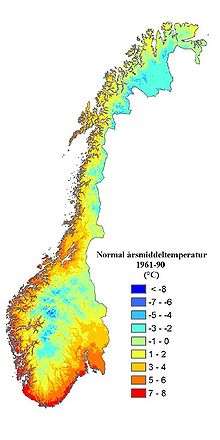
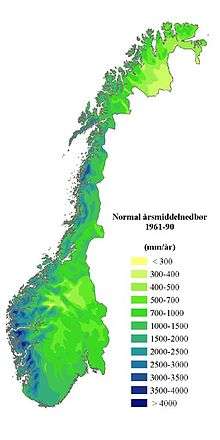
Because of the gulf stream, the climate in Norway, especially along the coast, is noticeably warmer than what would otherwise be expected at such a high latitude. Although half the length of Norway is north of the Arctic circle, the climate is not Arctic. Summers can be moderately warm (up to 25–30°C, 75–85°F), even in northern areas, but only for limited periods. The length of the winter and amount of snow varies considerably. In the north there is more snow and winters are dark; on the southern and western coast, winters are moderate and rainy. Further inland (North Norway and East Norway) the temperature can easily fall below -25°C (-15°F). In the interior of Finnmark -25°C to -35°C is common in January (record low at -50°C (-58°F)). Along the coast of Hordaland and Rogaland temperatures only occasionally and briefly drop below -5°C (20°F). Some mountain areas have glaciers and permanent snow, but there is no permafrost on the mainland.
While the coast of West Norway is among the rainiest in Europe, East Norway is largely in the rain shadow and relatively dry. In fact, northern Oppland is among the driest areas in Europe (comparable to dry areas in Spain and Greece). The interior of North Norway also obtains very little precipitation. Longyearbyen in Svalbard gets less than 200 mm precipitation per year similar to Almeria in Spain.
Norway's hours of daylight, temperature and driving conditions vary greatly throughout the year. Seasonal variations crucially depend on region (distance from ocean) and latitude as well as altitude. The area with midnight sun (north of the arctic circle) also has winter darkness (polar night) when the sun does not rise above the horizon at all.
| Where | July | January |
|---|---|---|
| Oslo | 16.4°C | -4.3°C |
| Lillehammer | 14.7°C | -9.1°C |
| Bergen | 14.3°C | 1.3°C |
| Trondheim | 13.0°C | -3.0°C |
| Tromsø | 11.8°C | -4.4°C |
| Alta | 13.4°C | -8.7°C |
| Kautokeino | 12.4°C | -14.7°C |
Norwegian weather is most pleasant during the summer (May to early September). If you like snow, go to Norway in December to April. Along the coasts and in southern part of West Norway there is little snow or frost and few opportunities for skiing, even in winter. In the mountains there is snow until May and some mountain passes are closed until the end of May. If you come in the beginning of May some passes can be still closed, but since the snow is melting very quickly, you will get a possibility to enjoy plenty of waterfalls before they disappear. And in this time the number of tourists is very small. Spring in Norway is quite intense due to the abundance of water (melting snow) in conjunction with plenty of sunlight and quickly rising temperatures (typically in May). Complete forecasts and statistics.
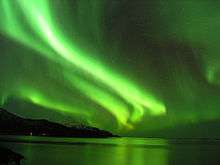
Daylight
Be aware that daylight varies greatly during the year. In Oslo, the sun sets at around 15:30 in December. North of the Arctic Circle one can experience the midnight sun and polar night (winter darkness). However, even at Oslo's latitude, summer nights exist only in the form of prolonged twilight during June and July, these gentle "white nights" can also be a nice and unusual experience for visitors. The polar (or northern) light (aurora borealis) occurs in the darker months, frequently at high latitudes (Northern Norway) but occasionally also further South.
| City | Start darkness | End darkness | Midnight sun | End midnight sun | Notes |
|---|---|---|---|---|---|
| Bodø | na | na | June 4 | July 8 | No winter darkness |
| Tromsø | November 27 | January 15 | May 20 | July 22 | |
| Svolvær | December 7 | January 5 | May 28 | July 14 | |
| Alta | November 25 | January 17 | May 19 | July 24 | |
| Nordkapp | November 20 | January 22 | May 14 | July 29 | |
| Longyearbyen | October 26 | February 16 | April 20 | August 22 |
Because of very long twilight at northern latitudes, there is usable daylight 1-2 hours after sunset. In summer this means that for instance in Trondheim midsummer nights are not dark at all.
| City | Sun rise June 21 | Sun set June 21 | Sun rise December | Sun set December |
|---|---|---|---|---|
| Kristiansand | 4:25 | 22:35 | 9:15 | 15:40 |
| Oslo | 3:55 | 22:45 | 9:20 | 15:10 |
| Bergen | 4:10 | 23:10 | 9:45 | 15:30 |
| Trondheim | 3:00 | 23:40 | 10:00 | 14:30 |
| Tromsø | midnight sun | midnight sun | polar night | polar night |
Holidays
The major holidays are Easter, Christmas (Christmas Eve, Christmas Day and Boxing Day are all considered holidays), and the "common vacation" throughout July. In May there are several holidays including constitution day (17 May) - the main national celebration and an attraction in itself.
Public holidays (schools and offices closed):
- January 1 - New Year's Day
- Maundy Thursday (Holy Thursday, "Skjærtorsdag")
- Good Friday ("Langfredag")
- Easter Sunday ("påskedag")
- Second day of Easter (Monday) ("andre påskedag")
- May 1 - Labour day
- May 17 - Constitution Day
- Ascension Thursday ("Kristi himmelfart")
- Pentecost (Whit Sunday, "pinsedag")
- Pentecost 2ed (Whit Monday, "andre pinsedag")
- December 25 - Christmas Day ("juledag")
- December 26 - Boxing Day ("andre juledag")
Many Norwegian holidays are celebrated on the day before (Holy Saturday, Christmas Eve etc.). On Christmas Eve ("julekveld", "julaften"), New Year's Eve ("nyttårsaften"), Holy Saturday ("påskeaften") and Saturday before Pentecost ("pinseaften") shops close early. Norwegians also celebrate midsummer at St. John's day on 24 June by making a bonfire late evening the day before - "St.John's Eve" ("St.Hansaften" or "Jonsokaften").
Read
Classical travel journals
- W. Matthiue Williams: Through Norway With a Knapsack (1859)
- Mary Wollstonecraft: Letters written during a short residence in Sweden, Norway and Denmark (1796)
- Thomas Malthus: Travel journal from Norway (1799)
- Samuel Beckett: The fjords and folk of Norway (1915)
- W.C. Slingsby: Norway: the Northern Playground (1904)
- Dhiravat na Pombejra: A Month in Norway: King Chulalongkorn's travels July–August 1907.
- Robert Everest: A journey through Norway, Lapland, and part of Sweden: with some remarks on the geology of the country, its climate and scenery. (1829)
- Lees, James A. and Clutterbuck, Walter J: Three in Norway (by two of them) (1912)
Get in
Entry requirements
|
Minimum validity of travel documents
|
Norway is a member of the Schengen Agreement.
- There are normally no border controls between countries that have signed and implemented the treaty. This includes most of the European Union and a few other countries.
- There are usually identity checks before boarding international flights or boats. Sometimes there are temporary border controls at land borders.
- Likewise, a visa granted for any Schengen member is valid in all other countries that have signed and implemented the treaty.
- Please see Travelling around the Schengen Area for more information on how the scheme works, which countries are members and what the requirements are for your nationality.
- Still there is identity check before boarding flights or boats into Norway.
Russians who live within 30km from the border may enter Norway visa-free for up to 15 days, provided they have been resident in the border area for at least 3 years, and do not travel more than 30km from the border. A border certificate, which is valid for multiple entries, must be obtained from the Norwegian consulate in Murmansk in advance.
Citizens of Andorra, Argentina, Australia, Brazil, Brunei, Canada, Chile, Costa Rica, Croatia, El Salvador, Guatemala, Honduras, Israel, Japan, Malaysia, Mexico, Monaco, Montenegro*, New Zealand, Nicaragua, North Macedonia*, Panama, Paraguay, San Marino, Singapore, South Korea, United States, Uruguay, Vatican City, Venezuela, as well as holders of Hong Kong SAR or Macau SAR passports are permitted to work in Norway without the need to obtain a visa or any further authorisation for the period of their 90 day visa-free stay. However, this ability to work visa-free does not necessarily extend to other Schengen countries.
Be keenly aware that Norway is not a member of the European Union. This means, especially if arriving by plane, that all persons entering Norway, regardless of point of origin, may be subject to customs controls at the port of entry. Information on duty-free allowances and regulations can be found on the Norwegian Customs website.
While Svalbard has no border controls, most regular flights depart from Norway, so foreign visitors need to clear Norwegian immigration control.
By plane
Oslo
- For more information on facilities at and around Oslo Airport, Gardermoen, see the Oslo Airport, Gardermoen article.
Oslo Airport, Gardermoen (OSL IATA) is the biggest airport in Norway and the main international hub, at Gardermoen 60 km (37 mi) north of Oslo. The airport is served by many major international and most domestic airlines.
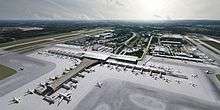
The airport has scheduled flights to around 100 destinations abroad and 24 domestic destinations in Norway.
From the United Kingdom there are direct services to Oslo Gardermoen from:
- Aberdeen (Scandinavian Airlines)
- Edinburgh (Norwegian Air Shuttle)
- London Heathrow (Scandinavian Airlines and British Airways)
- London Gatwick (Norwegian Air Shuttle)
- London Luton (Wizz Air)
- London Stansted (Ryanair)
- Manchester Airport (Scandinavian Airlines and Norwegian Air Shuttle)
From Ireland:
- Dublin (Scandinavian Airlines, Norwegian Air Shuttle)
From the United States:
- Boston, MA (Norwegian Air Shuttle) (seasonal)
- Fort Lauderdale, FL (Norwegian Air Shuttle)
- Las Vegas, NV (Norwegian Air Shuttle) (seasonal)
- Los Angeles International Airport, CA (Norwegian Air Shuttle)
- Miami, FL (Scandinavian Airlines)
- Newark Liberty Airport, NJ (Scandinavian Airlines)
- JFK Airport, New York (Norwegian Air Shuttle)
- Oakland, CA (Norwegian Air Shuttle) (seasonal)
- Orlando, FL (Norwegian Air Shuttle)
From Australia and New Zealand, the quickest connection is via Bangkok, Doha or Dubai. Thai Airways and Norwegian Air Shuttle fly non-stop from Oslo to Bangkok. Both Qatar Airways and Emirates fly daily from Doha and Dubai respectively, with connections from several destinations in Asia and Oceania.
Sandefjord
Sandefjord Airport, Torp (TRF IATA) is located just north of Sandefjord, 115 km to the south of Oslo.
Sandefjord Airport Torp has scheduled flights to various destinations in Europe and in Norway.
From the United Kingdom there are direct services from:
- London-Stansted (Ryanair) (seasonal)
- Manchester Airport (Ryanair)
Stavanger
Stavanger Airport, Sola (SVG IATA) has scheduled flights to/from London, Amsterdam, Copenhagen, Frankfurt, Berlin, Paris, Kraków, Madrid, Nice and some other European cities.
From the United Kingdom there are direct flights from:
- London Heathrow (Scandinavian Airlines, British Airways)
- London Gatwick (Norwegian Air Shuttle)
- Newcastle (Loganair)
- Aberbeen (Scandinavian Airlines, Widerøe)
Bergen
Bergen Airport, Flesland (BGO IATA) has scheduled flights to/from major European cities as London, Copenhagen, Amsterdam, Berlin, Paris, Stockholm, Prague, Warsaw and other cities.
Apart from to previously mentioned airports there are domestic flights to Trondheim and Tromsø.
From the United Kingdom there are direct flights from:
- Aberdeen (Widerøe)
- London Gatwick (Norwegian)
- Edinburgh (Loganair) (seasonal)
- Glasgow (Loganair) (seasonal)
- Inverness (Loganair) (seasonal)
- Kirkwall (Loganair) (seasonal)
- Sumburgh (Bergen Air Transport) (Loganair) (seasonal)
From the United States there are seasonal direct flights from:
- Newburgh/ Stewart, NY (Norwegian Air Shuttle)
- Providence/ T. F. Green, RI (Norwegian Air Shuttle)
Kristiansand
Kristiansand Airport, Kjevik (KRS IATA) has direct flights to/from major European cities, notably Amsterdam, London and Copenhagen.
From the United Kingdom there are direct flights from:
- London Stansted (Widerøe)
Trondheim
Trondheim Airport, Værnes (TRD IATA) can be reached by direct flights from several European cities, notably Amsterdam, London and Copenhagen.
From the United Kingdom there are direct flights from:
- London Gatwick (Norwegian Air Shuttle).
Tromsø
Tromsø Airport (TOS IATA) has direct flights from London Gatwick with Norwegian Air Shuttle twice a week.
By train
There are trains from Sweden to Oslo, Trondheim and Narvik, with onwards inland connections.
For Oslo, daily service from Stockholm and Gothenburg. There are local services from Karlstad as well.
For Trondheim, the Nabotåget service from Östersund corresponds with one day and one night service from Stockholm, as well as the train from Sundsvall.
For Narvik, two trains run daily from Stockholm via Kiruna. Both are overnight.
Train schedules can be found on the website of the Norwegian State Railways and the Swedish Railways.
By bus
Several international bus lines run into Oslo from Sweden, the major operators being Eurolines, Swebus Express and Säfflebussen. Service to Gothenburg and Copenhagen is almost hourly. The service to Stockholm is also far more frequent than the train. Lavprisekspressen has cheap bus tickets between the large cities in Norway, Denmark and Sweden.
The minibus service between Kirkenes and Murmansk run three times per day. Contact Grenseland/Sovjetreiser (yes, they are actually still called that!) in Kirkenes for booking.
Other coach lines exist between Sweden and Bodø and Mo i Rana, as well as between Denmark and Stavanger.
By car
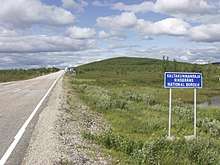
It is possible to enter by road from Sweden, Finland, or Russia. Major roads to Norway include European route E6 which runs through Malmö, Helsingborg and Göteborg in Sweden before crossing the border at Svinesund in the south-east of Norway, E8 which runs through Turku, Vaasa and Oulu in Finland before crossing the border at Kilpisjärvi. There is an enormous number of possible routes and border crossings, but keep in mind that the road standards vary, there are few motorways and that speed limits are low (generally 80km/h). Ferries from Denmark and Kiel (Germany) also takes cars (see boat section), and is a way to avoid long transport legs.
From Russia: European route 105 (E105) enters from Russia at Storskog border crossing 15 km east of Kirkenes. This is the only overland crossing between Norway and Russia. Crossing by vehicle (also bike) only, no pedestrians (as of 2015). Most people need a visa to cross.
By boat
From Belgium
DFDS operates a cargo line from Ghent to Brevik with limited passenger capacity which is normally for truck drivers. There are departures once or twice a week.The ferry may be scheduled to arrive at Brevik in the middle of the night.
From Germany
Color Line runs a daily ferry from Kiel to Oslo. The ferry leaves Kiel at 13:30 and arrives in Oslo at 09:30, the following day. The ferry terminal in Kiel is on Norwegenkai, which is a short walk across the bridge from Kiel's main railway station (the bridge may at times be closed for pedestrians due to ship traffic). At the Oslo end of the journey, the terminal is located at Hjortneskai, which is just west of the city. There is a bus from the terminal to the city centre, which departs shortly after passengers disembark.
From Denmark
Several companies run from various harbours in Denmark (Frederikshavn, Hirtshals, Copenhagen) to various Norwegian harbours (Oslo, Larvik, Kristiansand, Stavanger, Bergen).
- Color Line traffic from Hirtshals to Kristiansand and Larvik.
- Stena Line from Frederikshavn to Oslo.
- Fjord Line traffic from Hirtshals to Langesund, Stavanger and Bergen (Seasonal to Kristiansand).
- DFDS Seaways traffic from Copenhagen to Oslo.
From England
There are no ferry routes to the UK from Norway any more, although DFDS Seaways have been to known to allow passengers on their freight service from Immingham to Brevik.
Thomson Cruise ships operate from Harwich and visit Flåm, Bergen, Molde, Hammerfest, Nordkapp, Tromsø, Lofoten Islands, Geiranger and Ålesund in Norway. The duration of the cruise varies from 5 days up to 2 weeks. Sailing time from Harwich to south Norway is 1.5 days. The cruise ship has restaurants, bars, casinos, cinemas and also a stage show to keep you entertained during the journey. Various classes of cabins are available, ranging from shared rooms to singles, doubles and luxury suites.
Get around
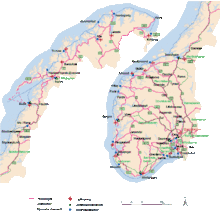
Norway is a wide country with some very difficult terrain so getting around, particularly up north, is expensive and time-consuming. Because of difficult terrain in large parts of the country, navigation is largely related to landscape features such as valleys, lakes, fjords and islands rather than to towns. Norway is sparsely populated compared to continental Europe; visitors should not expect that every name on the map is served by frequent public transport or offers commercial services such as taxi, cafés and hotels – it may not be a town or settlement at all. The best way to see the Norwegian wilderness and countryside is by having access to your own vehicle. This way you can stop wherever you want, admire the view and venture onto smaller roads.
By plane
As Norway's craggy coastline and mountainous terrain slow down overland traffic, domestic flights are a convenient option, especially in northern Norway where towns and cities are fewer and further between. Unfortunately, it is also in these areas where tickets can be most expensive. Planes between the small airports are small, and they generally have several intermediate stops along the route to embark and disembark passengers.
Flights in southern Norway are cheaper than in northern Norway, and even though this area has better roads and rail, planes are generally faster than taking the train or bus. There are however no air routes between the cities within 200 km from Oslo, use the train or bus for this kind of travel.
The largest operators are SAS, Norwegian and Widerøe.
If you plan to fly to the many smaller towns in Northern or Western Norway you should consider Widerøe's Explore Norway ticket (unlimited air travel for 14 days in summer for less than a full price return ticket).
By train
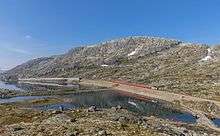
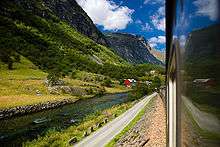
The state-owned railway firm Vy (formerly Norwegian State Railways or NSB) operates all railway lines except the airport express train Flytoget. Norway's rail network basically connects Oslo to other major cities, there are no rail lines North to South in West Norway between Stavanger and Trondheim, and there are no rail lines North-South in North Norway north of Bodø. These main lines run several times a day:
- Oslo–Kristiansand–Stavanger (Sørlandsbanen, runs inland from Drammen to Kristiansand, connections to Arendal)
- Oslo–Skien (serving coastal towns southwest of Oslo)
- Oslo–Bergen (Bergensbanen - Bergen line, across the mountains via Finse, connections to Flåm)
- Oslo–Trondheim (Dovrebanen, through Lillehammer, connections to Åndalsnes at Dombås)
- Oslo–Sarpsborg–Halden
- Hamar–Røros–Trondheim (Røros line)
- Trondheim–Bodø (Nordlandsbanen - Nordland line, through Trondheim airport, connections to Sweden), Norway’s longest, crosses the arctic circle
Trains are generally well-maintained and comfortable.
You can buy a Norwegian Rail Pass or the equivalent InterRail One Country Pass to travel cheap by train through Norway. If your itinerary is fixed and you don't have too many destinations, it might be cheaper to buy 'Minipris' tickets online. If you book well in advance, you can get one-way tickets for as little as 199 kr. When buying online, you can choose ticket delivery at the station or at the train, the latter means you only need to know your seat number, the train steward has your ticket. Their website sometimes does not work for people outside of Norway. In that case you can call their call centre, but be sure to mention that you tried on the website first. Phone reservations normally incur a 50-kr fee per train ticket bought. Vy has a phone app for buying tickets, but as of 2016, a Norwegian cell phone number is needed for it.
For long-distance trains and night trains, seat reservation is mandatory, but usually can be done on short notice, e.g., at a train station, since the trains are rarely fully booked. Generally, the trains are most crowded at the beginning and end of the weekend, i.e. Friday and Sunday evening. Shortly before and at the end of major holidays like Christmas/New Year and Easter, trains are usually very busy. If you try booking for these days at a late time, you may find all the cheap tickets sold out. Furthermore, the seat you reserve may be among the least desirable, that is, facing backwards, without recline, and facing towards and sharing the legroom with other passengers.
Night trains operate Oslo - Bergen, Kristiansand, Bergen, Trondheim and Bodø. With a regular ticket, you will get an ordinary seat, blanket and earplugs. Sleeping compartments are available for an extra of 750 kr. If you choose to order sleeping compartment, you pay for the compartment, not the bed: 2 people, same price. This also means that you will never have a stranger in your compartment.
For 90 kr you can upgrade any regular train ticket to NSB Komfort, the equivalent of first class, which means a little more room for your legs, free coffee, papers and a power socket. Usually the NSB Komfort coach is either the first or the last coach in the train, resulting in much less through traffic and a quieter environment.
The regular night train seats have a power plug, too. In some trains there is even free Internet access via Wi-Fi; one just needs to register (giving any 8-digit number as 'phone number').
Unlike much of Continental Europe, Norway does not have a high speed rail system, except for the route between Oslo and its airport. Attempts at implementing high speed trains are underway, but have failed so far. Therefore, a journey between the two largest cities, Bergen and Oslo, takes as much as six and a half to seven and a half hours.
In eastern Norway, where cities are closer together, there are several people who make a daily commute, and hence many of these cities have more frequent train service with hourly departures much of the day. This includes the cities in the counties of Østfold, Vestfold, Gjøvik, Hamar and Lillehammer. In general, these trains do not have seating reservations available, but it is still possible to upgrade to NSB Komfort.
If you get even closer to Oslo, there are local trains which may have departures as often as every 30 minutes. Local trains never have seating reservations, nor do they have a first class section. Local trains also operate between Bergen and Voss (sometimes to Myrdal), Stavanger and Egersund and around Trondheim.
By boat
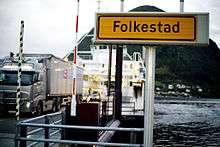
Car ferries are an integral part of the road network in coastal and fjord regions. The road in principle continues onto the ferry such that for instance Fodnes-Mannheller ferry is part of national route 5. Prices and time vary with the length of the crossing and amount of traffic, call 177 for more information or check nearby camping sites for information booklets and timetables. Prices on public roads ferries are set by the Department of roads. Small cars (as of 2018) are up 6.0 meters, longer vehicles must pay a considerably higher price and this often affects campervans.
Ferries often have information about other ferries in the region and other ferries along the same road. On the main roads ferries are frequent during daytime, typically every half hour. Reservations are usually not needed, drive to the ferry quay and wait in line until the ferry docks. Car ferries also take foot passengers. On main roads tourists typically do not have to worry about timetables as there are frequent departures. Most ferries do not run after midnight or they run only every second hour on main crossings. Norwegians refer to car ferries as "ferje" or "ferge". Vessels that only take foot passengers are refered to as "båt" (boat). To avoid confusion, visitors should use the term ferry only for car ferries.
Stretches with lots of ferries are desirable when bicycling, as the ferries are cheap for bicyclists and offer an often well-deserved break with a great view. Except for some of the shortest crossings (10 min), ferries typically have cafeterias serving coffee, cold beverages, sandwiches and some hot food. Due to numerous deep fjords and islands, driving in West Norway and Northern Norway as a rule (with few exceptions) involves ferries. Although car ferries are very reliable and operate with spare capacity, tourists should allow plenty of time on stretches including ferries. Ferries on unusually long crossings (several hours) or ferries crossing open stretches of sea are more frequently delayed or cancelled.
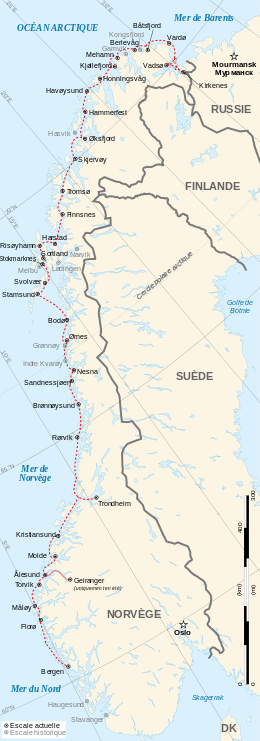
In regions with lots of fjords and islands, particularly along all the coast from Stavanger to Tromsø, an extensive network of catamaran express passenger boats ("hurtigbåt") shuttle between towns and cities, and connect islands otherwise accessible only with difficulty. There is no general network of boats connecting every village along fjords and coast, transfer by bus or car to nearest port may be needed. These vessels are also not called ferries. Service and prices are comparable with trains. Check in advance if you want to bring a bicycle. There are also some passengers in the inner part of Oslofjord.
One option particularly popular with tourists is the Hurtigruten coastal steamers that hop along the coastline from Bergen all the way to Kirkenes, taking five and a half days for the whole journey. Cabins are expensive and mandatory for multi-day journeys, but deck fares are more reasonable and there's even a 50% off discount with Inter Rail. Prices are summed up for all chargeable elements like persons, fuel charge (approx. 1/30 of a person), bike (approx. 1/20 of a person), car, cabin (approx. 125% of a person). Reservations are recommended for cabins and cars; on deck is usually enough space for persons and bikes.
Lakes do in general not have public transport by boat, here are however a handful of important exceptions. There is one car ferry crossing the very long Randsfjorden lake. Skibladner, a 150-year-old steam boat, allows tourists to cross lake Mjøsa (at Gjøvik and Hamar) the old way. Telemark canal, Norway's only proper canal, takes visitors from the coast and deep inland along charming lakes and impressive locks.
By bus
An extensive range of express buses connect cities all over Norway and even most national parks. NOR-WAY Bussekspress, Timekspressen and Boreal Transport are the biggest operators. Nettbuss also runs some express routes.
Lavprisekspressen offer cheap tickets for Oslo—Trondheim (via Røros and via the Dovre mountain range), Oslo—Kristiansand—Stavanger and back. If you're lucky, you can get a ticket for as little as 49kr, but usually the tickets go from 199kr to 299kr. The double decker buses are clean and modern with free Wi-Fi internet, coffee and tea.
Bus schedules and frequencies vary greatly, and seating may be limited, so plan ahead. For more information check each operator's website or try the extensive connection search Rutebok.no – available in English, Norwegian and German. Some mountain passes are closed all winter, and buses covering these typically run May—September only.
In the north of Norway north of Trondheim, there are no private express buses. Instead the provinces organise also long-distance buses, which also stop at local stops, having sparse schedules. There is no bus Trondheim–Bodø, instead the stretch is served by train (Nordlandsbanen line). There are for example comfortable buses Bodø–Narvik, Narvik–Tromsø, Tromsø–Alta and Alta-Kirkenes (they are daytime buses and accommodation is needed at Narvik, Tromsø and Alta if going all that way).
By taxi
Travelling with cab in Norway can be very expensive, and in most cities it is not necessary as bus, tram and train (or even walking) are easier. Taxis are generally safe as long as you choose a licensed taxi (with a white taxi sign on the roof). In villages there may be no or only one taxi car, so visitors should be prepared to book in advance.
- ☎ 02393 conveys taxis throughout the country. The service, which costs 18kr per call is reachable within Norway only. In some cities, like Oslo, Trondheim and Kristiansand are several local taxi companies.
- By the Taxi app "mivay" you will easily get in touch with the nearest taxi service center in densely populated areas.
By car or motorcycle
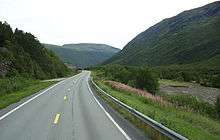
For more details see: Driving in Norway
Norway has right hand traffic, like the rest of mainland Europe. Norwegian roads have varying quality, but all public roads have asphalt. Most roads are two-lane undivided, there is a limited motorway network around Oslo. General speed limit is 80km/h and speed is often slower due to road conditions. Driving in winter requires special equipment, snow and ice experience is highly recommended prior to a winter trip. Some of the scenic mountain passes, notably at Geiranger, Trollstigen and Nordkapp (North Cape), are closed during winter.
Driving is generally easy as traffic is calm, and most drivers are disciplined and law abiding, although moderate speeding is common on highways. However, some city centres (such as Bergen and Oslo) may be confusing to navigate for the first time visitor due to many one-way streets. Traffic is generally light except for city centres and a handful of stretches on main roads (notably E18 near Oslo). Near or inside Oslo the E18, E6 and ring roads can get congested during morning and afternoon rush, as well as during weekend rush (Friday afternoon) out of Oslo. Gas is expensive, starting at around 16.50 kr per litre (July 2018). Manual transmission is regarded as standard in Norway and is found in most private cars. Renting a car is very expensive, but can be essential for easy access to some of the more rural areas, although most areas have a good reliable bus service.
Some rules:
- Headlights are mandatory even during daylight.
- Off-roading is generally forbidden. Motor vehicles must stay on public roads.
- Don't drink and drive. Your blood alcohol concentration must not exceed 0.2 ‰ (or 0.02 %).
- Rules are strictly enforced, particularly regarding alcohol, speed and overtaking.
By bicycle
While the bicycle seat may be one of the best ways to experience the landscapes of Norway, it can be a gruelling experience for those who are unfit. There are few bicycle paths, and most of the time cyclists have to share narrow roads with heavy transport. Attitudes to cyclists vary. While some drivers show respect, slowing down and giving cyclists a wide berth, others show hostility, driving far too close and at far too high a speed, when passing. Cycling, as a sport, is becoming increasingly popular in Norway, especially since the success of Norwegian cyclists like Thor Hushovd. Attitudes to bicycle tourists vary, but in general is positive. Hostels and camping sites are generally a good place to meet people with similar interests. Norwegians themselves prefer to ride on well equipped, often expensive, bicycles. Good bicycle shops can be found in most cities.
You will find quite a number of travel diaries online. Only few designated cycle paths exist, mostly in the big cities, and they are not fully interconnected. Except for densely populated areas, they can mostly be ignored. While speed limits are relatively low and the vast majority of drivers are responsible and patient, Norway also has its share of speeders and road hogs. At places where a highway is built, the old road is often re-designated as a cycle route.
It is important for cyclists to be seen. The use of highly reflective safety vests, along with flashing lights on the bicycle, is encouraged to help prevent accidents.
In most of Norway, cycling can be physically challenging, due to steep climbs and strong winds. Your equipment should be lightweight and aerodynamic. You will need a wide range of gears: a ratio of 39-27 for a strong cyclist without luggage or even 22-32 for a normal cyclist with luggage is necessary on many slopes. Your brakes should be of high quality and you'll need spare brake pads when doing a trip of more than a few days. Lights are necessary because of the many tunnels. Because of the winds, it is advisable to avoid wide panniers and loose fitting clothes. A lightweight recumbent should be considered as a serious option for those experienced with this type of bicycle, especially when cycling south to north.
The roads are generally paved well, although gravel roads are sometimes unavoidable. As long as you do not go off-road, you will not need suspension or grooved tyres.
Because of the long distances and numerous hills, bicycle tourists are advised to plan well and be prepared to use public transport for the less interesting or difficult stretches. Particularly in western and northern Norway, passenger boats (including longer tourist ferries) can sometimes be used to avoid tunnels, mountain passes or less interesting stretches.
Ferries take bikes for free or a minimal charge. On trains you have to pay a fare. Some buses do not allow bikes, but in all other cases will only be transported if there is enough space (no fare or children's fare). The Norwegian Cyclist Association offers information.
It is legal in Norway (and Finland and Sweden) to put up a tent anywhere for one night. This must not be too near someone's home, or on other unsuitable places. This is particularly suitable for bicyclists, who can roll the bike into the forest at a suitable place. It is more troublesome for car drivers to do this, as it is hard to find a good parking place near a suitable tent place (car parking is not permitted on private roads, e.g. in the forest).
Tunnels
Special attention should be given to tunnels, as many of them are forbidden for cyclists, as are a few roads. Some long and narrow tunnels are not recommended for bikes, even if allowed. An online map of tunnels can be found. The tourist information also has a map of those forbidden routes. When renting a bike, you can consult the person who rents you the bike concerning the track you want to take. In many cases, signposts indicate the route for cyclists and pedestrians around forbidden roads or tunnels. Some of the high speed tunnels have bus stops a short distance from the entrance where you can board special buses equipped with bike racks to transport you through the tunnel. On main roads, buses usually run frequently. Some sub-sea tunnels are in addition really steep. If you do enter a tunnel on bike, use lights and safety reflectors (such as reflector jackets or vests). Norwegian drivers do not slow down in tunnels.
Warning: Do not underestimate the number and length of tunnels, particularly in western Norway. Norway's roads have well over 1,000 tunnels. On the E16 between Bergen and Lærdal for instance, 30–50% of the road is in tunnel. Frequently, tunnels replace an older road that remains open for bicycles and pedestrians in summer or for local traffic all year. Ask locals or read the map carefully to find your way.
By thumb
Hitchhiking in Norway is best on the routes from Oslo-Trondheim (E6), Oslo-Kristiansand (E18) and Kristiansand-Stavanger (E39). However, near the cities these are now motorways and it is not possible to stand at the road itself. Hitchhiking is not that common in Norway. If hitchhiking is ever safe, it is pretty safe in Norway, however it is difficult to get a lift and it may be very slow.
When waiting, make sure to stand in a place where the vehicles can see you and have a safe opportunity to stop. Ferry ports and main fuel stations are good places to try. Stretches with low speed limits (50–60km/h) are generally better than high speed roads, as drivers find it less cumbersome to make a halt there. Drivers of heavy trucks in particular prefer to keep a steady speed. Roadside cafeterias where truckers have a break can be good place to ask for a lift.
Good hitchhiking spots from major cities are:-
Oslo to:
- Bergen and the mountains- if you're daring, try Oksenøyveien (see Kristiansand), but be aware that most cars continue southwards to Drammen. Rather catch the Timekspressen bus, direction Hønefoss, to Sollihøgda.
- Trondheim and the north- is getting more difficult as motorway development continues. The best bet inside Oslo is bus stop Ulvenkrysset. Get the metro to Helsfyr, then bus 76, 401 or 411 for one stop. Further outside, to avoid the local traffic, you are best off at the Shell gas station at Skedsmovollen, bus 845 and 848 from Lillestrøm train station.
- Kristiansand and the south: Few spots beat the bus stop Oksenøyveien, connected by bus 151, 251 and 252. You may be dropped in Sandvika by cars heading towards Hønefoss and the mountains/Bergen. Carry a sign.
- Sweden along E6: Highway all the way, except close to the centre. Try the bus stop Nedre Bekkelaget, bus 81 and 83.
- Sweden along E18: You may try Nedre Bekkelaget, but as most traffic continue towards Strömstad and Gothenburg, you should rather catch the Timekspressen bus 9 to Østensjø stop, just after the Holstad roundabout.
Bergen to:
- Oslo - Get local train to Arna and try near the entrance to Arnanipa tunnel.
- Northwards - Go by bus to Vågsbotn in Arna, and try hithing a ride close to the Hjelle bakery.
- Southwards - Get the light rail to Nesttun, then nearly any bus for three stops to Skjoldskiftet. Hitch southwards along E39.
Trondheim to Oslo - Get bus 46 to the shopping centre City Syd, then go under the E6 and try your luck at City Syd E6 stop. Soon, the city tax on buses will be extended past the Klett roundabout, if this is in effect you should go to the bus stop just after the roundabout at any Melhus-bound bus and try your luck there.
Molde/Ålesund - Get any Orkanger bus to the stop just after Klett roundabout. Soon, Trondheim city tax will extend to Børsa, after which you should stay on the bus for as long as you can, and hitch a ride from there.
- Northwards - Get city bus 7 or 66 to Travbanen stop.
- Sweden - To be sure to hitch only on cars going towards Sweden, get a train or bus to Stjørdal and hitch on the E14.
Looking polite and friendly is a good trick. Asking cars in line at a ferry quay (if travelling along the coast) is a very good idea, and may bring you very far. Hitching rides from Molde all the way to Bergen are not unheard of, but don't bet on it. In general though, you can really get to anywhere from anywhere by thumb, just in some places it might take a while.
Talk
- See also: Norwegian phrasebook
There is no standard spoken Norwegian (norsk) – a wide range of dialects is used even in public broadcasting. There are even two standard ways of writing it, Bokmål and Nynorsk. Norwegians learn both at school. The two varieties are very close and mostly mutually intelligible with the two other Scandinavian languages, Danish and Swedish. Bokmål is by far the more common form in most of the country, though Nynorsk is prevalent in Western Norway. Norwegian is very similar to Danish, but pronunciation is quite different and speakers may have difficulty understanding each other. Spoken Norwegian and Swedish sound more similar, but the vocabulary differs notably. Norwegians usually understand spoken Swedish and written Danish well.
Many of the younger retail and hospitality workers in Norway are Swedish, and make themselves understood in Swedish with a few Norwegian words added.
Sami is a minority language that has official status in some northern regions, completely different from Norwegian. Road signs and other public information there is provided in both Norwegian and Sami. Norwegian and Sami place names may differ – maps will typically use the Norwegian name. Sami is quite closely related to the Finnish language (not enough for comprehension, though), thus totally unrelated to Indo-European languages such as Norwegian or English (but there are quite a few loanwords).
English
Almost all Norwegians speak English and you should have no trouble getting around in English; 91% of the population can speak English, with most younger people having near native fluency, making Norway one of the most English proficient countries where English is not an official language.
Many people learn French, German and/or Spanish as well. As a Germanic language, Norwegian is also related to German and English. Many basic English words are similar to Norwegian, such as "brød" (bread), "dør" (door), "hus" (house) or "hund" (hound). In fact there is a large number of originally Norwegian (or Danish) words in English (as Vikings settled in and ruled big parts of the British Isles; cf the Danelaw). Norwegian and English syntax is also similar.
Foreign films and television programmes are generally shown in their original language with subtitles. Only children's programmes are dubbed into Norwegian.
See
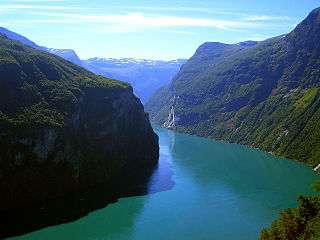
Norway has plenty of rural attractions - mountains, fjords, islands, glaciers, waterfalls, forests and small villages. Norway's natural and cultural sights often coincide, such as an impressive mountain road within a great scenery or the ancient stave churches located in the most serene landscape.
Natural
Norway has an abundance of water in all forms: glaciers, snow, fjords, rivers, waterfalls and lakes. Other attractions worth a visit are the northernmost point of Europe at Nordkapp, the islands of Lofoten, the glacier of Jostedalsbreen and the mountains of Jotunheimen.
Lakes
.jpg)
Norway has countless lakes and even inside Oslo there are several hundred. Hornindalsvatnet lake near Stryn and Hellesylt is the deepest lake in Europe at 514 meters, if the lake was completely drained rivers would need 20 years to fill it. Hornindalsvatnet is also unusually clear largely because it unlike many other lakes does not receive glacial meltwater with a characteristic milky turquoise color. Lake Mjøsa, Norway's largest, is the second deepest in Europe. The largest lakes are found in the lowlands of East Norway. Sogn og Fjordane and Telemark have a large number of pretty fjord-like lakes. There are also many lakes around Jotunheimen and other uplands.
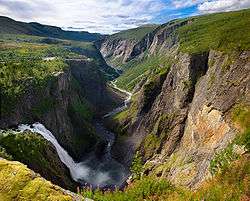
Waterfalls
Norway has an abundance of waterfalls, in all sizes and shapes. Norway is home to a notable number of the world's tallest waterfalls, particularly in the central mountains and Western Norway. The tallest waterfalls are eastern most parts of western Norway where the great fjords intersect with the central mountains. Sunndal, Romsdal, Geirangerfjord, Stryn, Lysefjorden (Ryfylke district), Byrkjelo, Sognefjord area (Flåm, Gudvangen, Lærdal, Skjolden) and Hardanger are areas with a large number of tall and easily accessible waterfalls. The more powerfall waterfalls are usually lower and found along major rivers in the big valleys for instance in Gudbrandsdalen, Valdres, inner Troms or Telemark. Many waterfalls are surprisingly accessible as they are often found close to main roads or railways, some plunge directly into the great fjords close to ferries and cruise ships.
Fjords
- For more information on fjords, see the Fjords of Norway article.
Norway's famous fjords are found throughout the country and are not limited to a particular region or location. All major cities sit on the shores of a fjord. While the most picturesque fjords are less populated, most are easily accessible by road. The fjords increases Norway's coastline from a modest 3000km to 30,000km, islands add another 70,000km - in total creating the most complex coastline in the world. Norwegian fjords have twice been rated the best destination in the world by National Geographic Traveler.
There are well over 1,000 distinct (named) fjords in Norway. The vast Sognefjord is some 200km to the far end and includes a number of arms each about the size of the famous Milford Sound in New Zealand. Some fjords are very narrow, such as Geirangerfjord and Nærøyfjord, others are wide like bays or enclosed oceans, such as Boknafjord or Trondheimsfjord. In most parts of Norway fjords are the dominant landscape features, traditional districts are often identified by proximity to a major fjord and the district or region often have the same name as the dominant fjord. For instance Sogn is the area surrounding Sognefjord. Fjords are often so deep and/or wide (particularly in western Norway) that they can only be crossed by ferry (a few daring bridges or tunnels have been built). Today fjords remain as obstacles for roads and railways, only cruise passengers experience travel along these vast corridors.
In large parts of Norway there is in fact very little continuous land, instead a wide tangle of islands and peninsulas. These peninsulas are often connected to the actual mainland by (narrow) isthmuses. Such isthmuses are shortcuts between fjords and have always been important transport corridors. Still today main roads often run across these such isthmuses. In many cases such isthmuses sits between a saltwater fjord and a freshwater lake (in effect an extension of the lake), for instance at Nordfjordeid ("Nordfjord isthmus") sits between Nordfjord and Hornindal lake.
- Fjord regions
- Western Fjords: The most dramatic and famous fjords are largely in West Norway, approximately from Stavanger to Molde. Although the western fjords vary slightly in appearance they are generally relatively narrow, surrounded by steep rock faces, tall mountains and extremely deep (particularly the middle and innermost parts). These typical features of western fjords are most pronounced at the easternmost part where fjords intersect with the highest mountains (such as Jotunheimen). Melt water from glaciers flow into major fjords such as Sognefjorden. The fjords of western Norway (represented by fjords of Geiranger and Nærøy) is a UNESCO world heritage site
- Nordland and Troms: These counties are also home to wild landscapes with alpine summits, islands and impressive fjords. The narrow strait into Skjerstadfjorden at Bodø creates the world's strongest tidal current, the Saltstraumen.
- Middle Norway: The fjords of Trøndelag, notably the large Trondheimsfjord, are less dramatic but still dominates the landscape. The Trondheimsfjord runs from the large Hitra island to the interior town of Steinkjer. The central part of this fjord is like a small enclosed ocean.
- East Norway: The fjords in the wider Oslo region, primarily Oslofjord, are also key to the geography of these lowlands and flatlands, similar to the Trondheimsfjord. The Drammensfjord is an important arm of the great Oslofjord. There are no saltwater fjords in the interior of East Norway, but there are countless lakes many of which resemble western fjords and are in fact called "fjord", for instance the long narrow Randsfjorden is a lake.
- South Norway has some scattered fjords, but smallish compared to the wild fjords of the west and the wide Trondheimsfjord.
- The fjords of eastern Finnmark are far less dramatic but these long and wide fjords dominate the landscape.
- Fjord-lakes
Many freshwater lakes in the interior are called fjords, for instance Randsfjorden and Tyrifjorden, even lake Mjøsa is called "the fjord" by locals. These lakes are very similar to saltwater fjords with a typical elongated shape and also mostly deep. Mjøsa for instance is 450 meters deep such that most of the lake is in fact below sea level even if water surface is 120 meters. Several lakes in Western Norway are in fact extensions of the main fjord and some were in the geological prehistory part of the saltwater fjord itself. For instance the surface of the very deep Hornindal lake is only 50m above sea-level and separated from Nordfjord by a low isthmus. These western lakes are often so similar to the fjord that only the lack of salt reveals that it is indeed a lake.
Northern lights and midnight sun
If you want to see the northern lights, CNN has Tromsø on top of its list of best places to see it. Tromsø should also be visited during summer to see the midnight sun. Of course both can be enjoyed anywhere in the northern parts of the country. Northern lights is most frequent roughly north of arctic circle (from Bodø and further north). Because the midnight sun occurs in the same area, these phenomena can not be experienced at the same time. As northern lights otherwise is not restricted to a specific location, a dark night and clear sky are the only prerequisites. Clear sky correlates with cold weather, so visitors should be well-dressed, particularly November to March. Midnight sun and, more importantly, 24-hour daylight occur around midsummer north of the arctic circle - the further north, the longer the midnight sun season. At midwinter there is a corresponding period when sun is below the horizon and there is no real daylight (so called polar night).
Wildlife
Norway has an abundance of birds particularly along the coast. Some bird cliffs with millions nesting birds are protected as natural reserves. The sea fisheries are very rich although a limited number of species and dominated by cod. Sea mammals such as killer whales, harbour porpoise and seals are seen along the coast or in fjords occasionally or during particular seasons. There are tree major kind of big game: The moose («elg», «king of the forest»), red deer and reindeer. The moose is often seen along roads at dusk and dawn in the forest regions of East Norway and Trøndelag. The red deer exist in large numbers in Western Norway and can also be seen on meadows along roads particularly in spring and autumn. The wilde reindeer mostly roam the barren high plateaus and mountains, and are rarely seen by coincidence. Particularly in Northern Norway there are large numbers of domesticated reindeer.
Cultural
While most people don't pick Norway because they'd like to walk around in cities with museums, monuments, parks streetside cafés or luxurious restaurants, in Oslo and some other cities that's also an option. Just getting around in Norway by car, boat, train, bike or foot usually rewards you with great views. Speaking of transportation, Norway is also where you should head to if you literally want to take a train ride to Hell!

UNESCO world heritage sites of the country are:
- The rock paintings of Alta
- The Vega archipelago
- Urnes stave church in Luster
- The mining town of Røros
- Bergen's waterfront, Bryggen
While Norway's cultural heritage is most pronounced in rural areas, Norway's cities also offer interesting cultural sights, old or new. Cities like Bergen, Ålesund, Kongsberg, Røros, Trondheim and others are interesting because of architecture and history. Norway's cities also offer fascinating modern architecture, most notable in the capital Oslo with landmark buildings such as the new Opera house and the University library, as well as the new controversial skyline downtown.
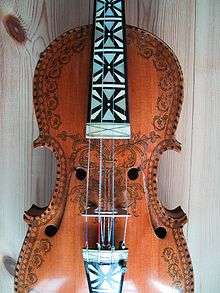
The hardanger fiddle (hardingfele) is a characteristic instrument from Norway. This idiosyncratic violin has four or five sympatheic or resonance strings beneath the standard four strings, and made from thin, delicate and decorated wood. The haunting, powerful sound is used to create traditional folk music: dance music as well as "listening music". The oldest hardanger fiddles are from the 17th centuries and one from 1650 is held at Bergen museum. Edvard Grieg and other modern composers incorporated folk music for the hardanger fiddle in their own music. The Sami people maintain their own musical tradition, notably the joik (or yoik) a characteristic form of singing. The Sami also used a ceremonial drum. Contemporary artists such as Mari Boine and Jan Garbarek have developed or incorporated Sami music in their own compositions.
Churches
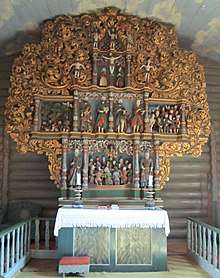
Outside main cities there are few if any monumental buildings except the local church. Norway hardly had any aristocracy that built palaces or imposing manors. Rural areas is dominated by wooden buildings, including most churches. From the middle ages about 30 idiosyncratic stave churches survived (from perhaps 1000), and some 100 stone churches. Most churches built after the Protestant Reformation are basic wooden "long" churches (rectangular shape), but there is also a number of other shapes such as the characterisic cruciform (cross shape) design with a central tower. The rare Y-shape exists in a small number of churches.
The octagonal shape was used for a larger number of churches and several landmark churches with this largly endemic style can be seen around Trøndelag, Møre og Romsdal, and Nordland as well as other areas. Many church interiors are in a barren protestant style, but there is a large number of churches with elaborate interios such as tolepainted walls, impressive wood cut altar pieces and pulpit designs. A large number of church are log buildings and logs are usually visible on the inside. In stave churches the elaborate construction is largely visible.
Several medieval winged altarpieces has been preserved in rural churches in Norway, including altarpieces installed before the Reformation. Many of these were imported from north German towns like Lübeck and the low countries, while for instance in the Netherlands altarpieces from that period are lost, several can be seen in Norway. In the 1700s elaborate wood carving and rosemaling (a kind of tole painting) were used in altarpieces and other decorations within churches, notably in the interior valleys.
Cityscapes
Oslo burned down in 1624 and was rebuilt in stone and brick only (in a grid pattern), and the rapid expansion in the 1800s makes Oslo different from most other towns. Trondheim and Kristiansand were both laid in a strict "military" grid pattern, while Bergen and many other wooden towns further south grew organically into a charming labyrinths. Ålesund burned down in 1904 and was rebuilt in a unique variant of art noveau (Jugendstil). Towns destroyed during the second world war (Molde, Kristiansund, Åndalsnes, Steinkjer, Namsos, Bodø, Narvik, Hammerfest, Kirkenes) were largely rebuilt in a less charming post-war style, although Kristiansund is an interesting example of bold urban planning. These World War II "burned towns" are also home to the first daring, untraditional church architecture.
Wooden towns
Typical for Norway is the widespread use of wood as building materials, even in centres of main cities like Bergen, Stavanger and Trondheim, and the friendly atmosphere created by the many modest buildings. Some wooden cities have been lost to fire, for instance Ålesund (fire in 1904, rebuilt in local Jugend-style) and Steinkjer (bombing second world war). Molde, Kristiansund, Bodø, Narvik and all of Finnmark were destroyed during the war. Levanger and Trondheim were not harmed by the bombings and their wooden charm is largely retained. The wooden town of Røros is on the UNESCO world heritage list. A number of other towns has notable wooden architecture, for instance Lillehammer, Skudeneshavn, Lillesand, Risør, Arendal, Tvedestrand, Kristiansand, Farsund, Flekkefjord, Lærdal, Brevik, Drøbak and Son village. The wooden towns of the south/south-west coast is Norway's version of "pueblos blancos". The capital Oslo is in fact not very typical as the inner city is dominated by concrete and masonry structures, only small pockets of wooden houses exist in central parts of Oslo. Fire is a constant threat to these traditional towns and neighborhoods, and every year some parts if this heritage is lost.
Do
A great introduction to Norway is the one-day Norway in a Nutshell package on a single ticket from Oslo or Bergen into the mountains, with a boat trip through the fjords. You can break the trip at several interesting cabins for walking or just admiring the view, and even hire a mountain bike for part of the journey. One of the highlights of the 'Norway in a Nutshell' package is Flåmsbana, a 20 km railway that's one of the steepest in the world. Along the way you'll see beautiful mountains, rivers, valleys, waterfalls, and other beautiful sights on your way to the town of Flåm.
- Go on top of the nearest top/mountain. Just for the walk. And for the view.
Hiking
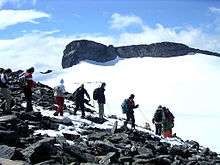
Hiking, gå på tur, is a national pastime in Norway, from easy walks in Oslo's city forest to alpine climbing in Jotunheimen or the "alps" of Troms. About 30% of Norway is covered in forest, more than 50% of Norway's total area is barren mountain (little or no vegetation), a mere 5% include farms and all sorts of built-up areas (houses, roads, towns, etc). A number of areas are protected as national parks, but most the country is equally attractive and available to the public. Skiing season is generally from mid-November to late April, while bare ground hiking season is generally from mid summer to September. Hiking season varies greatly depending on region (and from year to year): In the high mountains there may still be deep snow until July, while in the lower areas and along the coast hiking season start early spring. Visitors should be aware that the tree line is much lower in Norway than in continental Europe and US Rockies, high alpine conditions (no vegetation, glaciers, extremely rugged surface may start even at 1000 to 1500 metres above sea level).
Proper mountain clothing is needed for hikes even in summer in the uplands. The right foot wear is the essential for a successful hike. Hiking boots with ankle support and a sturdy sole on rougher trails and in the terrain, particularly at high altitudes (above 1000 to 1500 metres) where trails often cross wide screes or blockfields.
In Norway, travellers enjoy a right to access, which means it is possible to camp freely in most places for a couple of days, as long as you're not on cultivated land and provided you are at least 150m away from houses and farm buildings. Don't leave any traces and take your rubbish away for recycling.
Den Norske Turistforening (DNT) (The Norwegian Mountain Touring Association) operates many staffed and self-service mountain cabins, marks mountain routes, offers maps and route information, guided tours, and several other services for mountain hikers in Norway.
Mountainous areas are popular among both Norwegians and tourists. Tourists can visit Galdhøpiggen (2469m), the highest mountain in Norway, or join a musk ox safari in Dovrefjell.
Google Maps can only be used for initial planning, not for navigation in the field. Try the national mapping agency's Atlas.no site, which concords with their excellent printed hiking maps. Hikers in the wilderness should bring a detailed topographical map 1:50,000 (1:75,000 can also be used) and a compass. GPS (satelite navigation) is only supplement to, not a substitute for, traditional map and compass navigation.
Skiing
Both cross country and alpine skiing are popular sports in winter, and the largest areas, such as Trysil, Hafjell and Hemsedal, compete well with the Alps at lower altitudes. Telemark is also a nice area to ski in. (The birthplace of cross country ski.) Voss, Geilo and Oppdal are other major ski resorts. Even inside Oslo there is a notable ski resort. There is more than 200 alpine ski resorts and 500 ski lifts in Norway, and countless cross-country groomed trails, some with lighting to allow exercise after in winter evenings.
Winter sport resorts typically open in early December, whereas cross-country skiing may begin in November in some uplands. Around Oslo, within reach of the metro and city buses, there is a large park ideal for cross-country skiing, as well as hills for alpine skiing. In Stryn, at Galdhøpiggen and at Folgefonna there alpine ski centres that are open in summer only (May–September), offering unique opportunities for alpine skiing in T-shirt and short pants. Back-country skiing is popular in late winter and spring, and the season lasts until late May in the high plateaus/central mountains.

Dagens Næringsliv, the leading business daily, ranked the best alpine resorts (2013, 2016, 2018):
- Hemsedal - Norway's most complete alpine resort, can be compared to leading resorts in Austria and Canada.
- Trysil - Norway's largest winter resort, best for children, but it also has many steep pistes
- Hafjell - best snowpark, stable cold climate, 1994 olympics (rank #3 in 2016)
- Kvitfjell - Norway's toughest downhill slopes, 1994 Olympics
- Myrkdalen - in Voss district, heavy snowfall, open November-May
- Stranda - Norway's best offpiste skiing, heavy snowfalls (ranked #8 in 2016))
- Oppdal - some for all
- Geilo - well suited for families with diverse preferences
- Voss - ideal for day trips from Bergen# Lyngen - best summit skiing
- Hovden - best in South Norway, 200km from Kristiansand (ranked #6 in 2016)
- Røldal - in Odda district, heavy snowfall, second best off-piste, open until early May
- Narvik - second best off-piste, open until early May
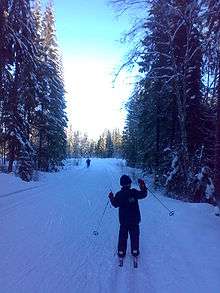
Best cross-country resorts according to Dagens Næringsliv:
- Beitostølen
- Geilo
- Golsfjellet
- Gålå
- Sjusjøen - 350 km trails
- Oslo - 2600 km trails (350 km with lights) inside the big city
- Rauland - stable snow in uplands
- Meråker
Dagens Næringsliv in 2014 ranked the winter sport resorts that have the most complete offer (alpine skiing, cross-country skiing in groomed tracks and "summit skiing"):
- Voss - offers everything, more unstable temperatures than the interior
- Tromsø - mediocre alpine facilities, but superb mountainous hinterland
- Hemsedal - all options in a high valley, stable winter
- Sogndal - excellent summit skiing options, lots of powder snow, limited facilities
- Røldal - steep hills and heavy snowfalls, few options for beginners and families
- Geilo - perfect for cross-country skiing and for families, limited off-piste options
- Oppdal - all options in a high valley, somewhat dated facilities
- Narvik - wild mountains directly on fjord, limited offers for families and cross-country skiers
- Lillehammer - excellent cross-country and alpine near the city, no high mountains
- Trysil - great variety of alpine slopes, well suited for families
Cycling
You can rent a bicycle virtually everywhere in Norway. Cycling routes exist usually near bigger cities; you can find some tours at Cycle tourism in Norway. Some roads and tunnels are forbidden for cyclists as they are life-threatening; read the section By bicycle above. Some city dumps may have a special section where you can pick up discarded bicycles (and other stuff) for free. The charity thrift-stores (FRETEX/ELEVATOR/NMS Gjenbruk) sometimes stock used bicycles.
Swimming
.jpg)
There are few sandy beaches and water is mostly cold, in salt water as well as fresh water. The coast of Skagerrak, parts of the Oslofjord for instance, can however get pleasantly warm in late summer. The coast is mostly rocky, but some areas have stretches of gently rounded, polished slabs of rock, "svaberg", these get quickly dry and warm in sunny weather, and is a popular hangout in summer. Except for the long sandy beaches south of Stavanger, there are few and only short stretches of sandy beaches.
Norway's towns have many indoor swimming pools and a few heated outdoor pools too. Visitors to pools are supposed to shower well and completely naked before going into the pool. Use proper swimwear, swimming in underwear is not accepted. Small children may change and shower with parents. Most indoor pools have saunas ("badstue" in Norwegian).
Other outdoor
White water rafting services
- Sjoa (Gudbrandsdalen area)
- Skjåk/Lom
- Valldal
- Voss
- Oppdal
- Jølster
Music
- See also: Nordic music
Norway has a bustling scene for both folk, classical and popular music, and is especially known for heavy metal music.
Buy
Money
|
Exchange rates for Norwegian kroner As of January 2019:
Exchange rates fluctuate. Current rates for these and other currencies are available from XE.com |
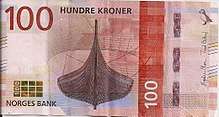
Norwegian currency is the Norwegian krone (crown, plural: kroner) (ISO code: NOK), sometimes abbreviated kr or kr., but often just the amount is shown on price tags. A 1/100th krone is called øre. Be careful when crossing borders to differentiate the Norwegian krone (NOK) from the Swedish (SEK) or Danish (DKK) krone.
Euros are generally not accepted in shops, except in some airports and international transport (flights, ferries).
Coins come in 1, 5, 10, and 20 kr. Paper notes come in 50, 100, 200, 500, and 1,000 kr. While price tags still include øre, for instance 9.99 kr, there are no coins smaller than 1 kroner so prices are rounded. As of 2018, Norway is in the process of renewing its banknote design. New 100 and 200 kr designs were launched in May 2017, and the old designs ceased to be legal tender one year after. And new 50 and 500 kr designs launched in October 2018, and it will likewise be possible to use the old 50 and 500 kr banknotes for one year after that (until October 2019). Finally, new 1000 kr notes will be launched in late 2019, and the old notes will be demonetized one year after.
Banking
ATMs in Norway are called Minibank. There is no problem locating an ATM machine in urban areas. At main airports and Oslo Central Station you can withdraw euros, dollars, British pounds, Swedish, Danish and Norwegian kroner. Nearly all stores accept major credit cards such as MasterCard and Visa (bring your passport/driving licence, as you are required to identify yourself when using a credit card). Matter of fact, Norway might well be the most card-centered country in the world, and you may encounter businesses where cash isn't accepted.
Costs
Norway is an expensive country for visitors. While the krone has fallen compared to major hard currencies since the record levels of the early 2010s, and it is possible to travel in Norway on a limited budget, some care must be taken. Because labour is costly, anything that can be seen as a "service" will in general be more expensive than you expect. Travel costs can also be a killer, because the country is large and distances long, so a rail or air pass can save you a lot of money.
If you are a bit careful about your expenses a daily budget of around 1,500 kr (€190) per day is not unrealistic. As rules of thumb, subsisting on under 500 kr/day will be difficult even if you stay in hostels and self-cater, with 1000 kr/day allowing a more comfortable mid-range lifestyle and over 2000 kr/day needed for good hotels and restaurants.
Take care when buying alcohol and tobacco. It will most certainly be more expensive than you expect. A 400 or 500 mL beer in a pub or restaurant will cost around 60 kr whilst a 500 mL can of 4.7% beer in a supermarket costs about 25 kr. Cigarettes cost about 100 kr for a pack of 20, and a bottle of 500 mL Coke will usually cost 20 kr in shops. On the positive side: Norway has good quality tap water. Buying bottled drinking water is unnecessary and hugely expensive.
Fast food restaurants like McDonald's and Burger King are also more expensive than in most countries due to the labour costs. A large Big Mac menu will set you back around 90 kr, the same goes for a Double Whopper Cheese menu. Also, keep in mind that most bakeries, fast food chains, and other types of restaurants that offer takeout, charge more if you eat it at the restaurant than if you take it with you, due to differences in the VAT rate.
You can save some money by bringing supplies. Norwegian border regulations are strict: they allow a maximum of 200 cigarettes or 250 grams of tobacco, 1 litre of hard alcohol and 1½ litre of wine and 2 litres of beer or 3 litres of wine and 2 litres of beer or 5 litres of beer. As a general rule, tobacco, alcohol and meat will be comparatively expensive. Vegetables, flour, baby articles, car supplies (oil, window wiper fluid and so on), and clothes will have (almost) the same price as in neighbouring countries, or even be cheaper.
Many Norwegians living near the borders with Sweden, Finland or Russia head into those countries to purchase groceries, as the costs are significantly cheaper. While the option of crossing into Russia is not available for most travellers due to Russia's onerous visa requirements, those visiting areas near the Swedish or Finnish borders should consider this option before travelling to other areas, as there are no border controls between Norway and Sweden or Finland. Except for the border areas near Oslo, Sweden and Finland are very sparsely populated near the Norwegian border. Still there are shops near the border, which wouldn't exist without Norway.
Tipping
Traditionally, the tip has not been common, but is being introduced by outside influence. Tipping should be given only as a token of real appreciation for the service.
In Norway, like most of Europe, waiters are not dependent on tips from customers as they are in the US, as they are well paid. However, tipping is not unusual in mid- to high-end cafés and restaurants, but only if you feel you have been treated well. In restaurants, even though there is a service fee, rounding up is the norm, and 10% is considered generous. It is not normal to tip outside restaurants and bars, but in situations where change is common it is polite to leave the change (for example, taxis). Tipping cab drivers is usual if you travel for more than 200 kr, but you will get no reaction from the driver should you choose not to tip, so this may be a new experience to American and English tourists. Tipping is never considered offensive, but not tipping is also rarely frowned upon.
Money exchange
It is possible to exchange money in most banks near tourist information offices, in the post-office or withdraw the money in local currency from the ATM. In some places, however, they don't handle cash in the banks so they only way to exchange money is in the post offices where the exchange fee might be up to 75 kr!
You will get the best rate when you withdraw money from the ATM or pay with a credit card. The country is upgrading to a new system using computer chips embedded in the card and a pin number. Credit cards with magnetic strips are still accepted throughout the country; however, you will have to let the merchant know that the you do not have a pin code you need to sign instead. Sometimes a merchant system will not allow signatures, so it is a good precaution to have cash on hand to pay if needed.
Shopping
Opening hours in Norway are better than they used to be, though many smaller stores still close early on Saturday (13:00 or 15:00 is typical) and nearly everything is closed on Sundays. Grocery stores (particularly in the cities) have long opening hours frequently until 22:00 or 23:00 on weekdays. You'll often see opening hours written as "9-21 (9-18)" on doors, meaning 9am to 9pm weekdays, 9am to 6pm Saturdays. The grocery market is dominated by a handful of chains covering most of Norway: Rema 1000, Kiwi, Prix and Bunnpris are low price shops with a narrow selection of items; Coop and Spar have wider selection and better quality at a slightly higher price; Meny, Mega and Ultra have fewer shops and higher prices.
Convenience stores, notably the major chains Narvesen and Mix (all over the country), Deli de Luca (bigger cities only) and 7-Eleven (bigger cities only), are open from early morning until late at night every day, with 24-hour service in the biggest cities. All over the country you will find gas-stations, Circle K, Shell, fresh/selected, YX (HydroTexaco) (these days turning into 7-eleven with gas) and Esso, On the Run. Virtually all gas-stations serve fast-food, especially sausages and cheese. Also hamburgers, pizza, and so on. The gas-stations have long opening periods, and the bigger stations in cities and near bigger crossroads are open 24 hours. Items sold in convenience stores and gas stations are relatively expensive.
Most big cities have over the years been almost exclusively dominated by shopping malls. Although you do have shopping streets like Karl Johans Gate in Oslo, Strandgaten in Bergen and Nordre gate/Olav Tryggvasons gate in Trondheim, you are bound to find malls around the country by Thon Gruppen and other major companies. Norway is also home to Scandinavias biggest mall - Sandvika Storsenter - 15 minutes outside Oslo by train. In Oslo you have Byporten Shopping Senter, Oslo City and Gunerius located right next to Oslo S train station and Paléet and Arkaden Shopping in Karl Johans Gate, as well as several malls and shopping centres a bit further out.
Getting "good deals" and bargaining is frowned upon, and the service workers are generally not authorized to give you a better price - only larger items such as cars are subject to haggling. The price you see is the price you pay. If you plan on buying tax-free, a good practice is to bring with you the necessary forms. Most stores will have these forms at hand themselves but it is a good precaution. Also, if you pay with a credit card, you might have to sign the receipt which will require some form of ID, driving licence and passport are both OK. This is due to the strict nature of money transactions.
Eat
- See also: Nordic cuisine
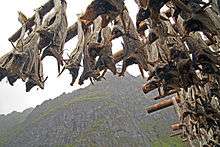
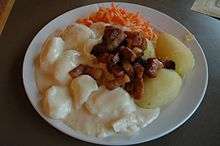
Norway is one of the worlds most expensive countries for eating, especially in restaurants, and also for retail food. Many visitors choose to bring camping food from another country.
Cuisine
While Norwegian eating habits have become more cosmopolitan in the last decades, traditional Norwegian "farm" food is still widely eaten, made by whatever can grow in the northern climate, be stored for a year until new crops come out, and contain enough energy for you to do hard work. Regional variances in traditional food are huge and hence, and what is thought to be "typical traditional" for one Norwegian might be totally unknown to another. Typical examples are variations of yeasted and unyeasted bread and other forms of bakery, porridges, soups, inventive uses of potato, salted and smoked meat, and fresh, salted or smoked fish. Dried cod (tørrfisk) and salted cod (klippfisk) are staples of coastal communities in the west and north and can be seen drying on outside racks in spring and summer. The national dish of Norway is fårikål, a stewed casserole of lamb's meat and cabbage. Other specialities include lutefisk (lyefish) made from dry/salted fish processed in lye, and potato dumplings served with salt meat (raspeball) or mixed with fish (blandeball). Sheep's head (smalahove) and dried mutton ribs (pinnekjøtt) are traditionally served before or during Christmas in Western Norway.
Finer traditional food is usually based on game or fresh fish. Steak, medallions and meat balls from game, deer, reindeer and elk are highly appreciated foods with international reputation, so are fresh, smoked and fermented salmon varieties as well as a host of other fish products. Traditional pastries like lukket valnøtt (marzipan-covered whipped cream cake) are other original contributions to international cuisine. Cheese of various types is common, but one particularly Norwegian favourite is brun geitost (brown goat-cheese), a mild sweet cheese which bears a remarkable similarity to smooth peanut butter in colour, texture and taste.
Today, Norwegians use plenty of sliced bread for almost any meal except dinner, whereas recipes for hot meals will be taken from almost anywhere in the world, including of course the traditional kitchen, but seldom the most extreme examples. Lunch usually consists of some bread and snacks instead of a warm dish but this is then compensated by eating well at dinner time. Most Norwegians don't go out for lunch, instead have a quick meal in the workplace.
Norway maintains high import tariffs for food; especially meat, dairy products, and alcoholic beverages. Norwegians who live near Sweden or Finland usually cross the border to buy these products.
Norwegians are also known for buying a lot of frozen pizzas at modest prices in any grocery store.
Places to eat
|
Whale anyone? Yes, Norwegians eat whale (hval). However, it's very seldom found in most ordinary restaurants, and chances are it might be overly expensive. In freezers at some supermarkets you may encounter whale meat as well. Young Norwegians did not grow up with eating whale because of the moratorium in the 1980s. Although whaling started up again in the early 1990s, whale is no longer a staple food as it once was in the coastal areas. Norway only allows a limited catch of the minke whale as this specific species is not regarded endangered. |
Fast food meals start from 50 kr and sit-down meals in a decent restaurant nearly always topping 200 kr or more for a main course. Even a take-away sandwich and a coffee at a gas station may cost you up to 70 kr. One way to cut costs is self-catering, as youth hostels and guesthouses often have kitchens for their guests. Supermarkets and grocery stores are not hard to find, even in the smallest village there is usually more than one grocery store. The largest chains are Coop, REMA 1000, Kiwi and Joker. Breakfast is often hearty and buffet-style, so pigging out at breakfast and skipping lunch is also an option. Buy/bring a lunchbox before attending breakfast, as most of the bigger hotels will allow you to fill it up for free from the breakfast buffet for eating later in the day.
For a cheap quick snack Norwegian-style, look no further than the nearest grill or convenience store, which will dish up a sausage (pølse) or hot dog (grillpølse) in either a hot dog bun (brød) or wrapped in a flat potato bread (lompe) for around 20-30 kr. However prices can soar as high as 50 kr if you buy at the right (read wrong) places. In addition to ketchup and mustard, optional toppings include pickled cucumber (sylteagurk), fried onion bits (stekt løk) and shrimp salad (rekesalat). To get the most for your money, order a (kebab i pita) which is lamb meat roasted on a spit then fried when you order, served together with vegetables in a pita bread. This tastes great, is extremely filling and can be found for as little as 40 kr in central Oslo. Outside, you will have to stick with your grillpølse.
Vegetarians
Some Norwegian cuisine restaurants have vegetarian meals on the menu, but others will make something if asked, with varying success. Some of the few chains of stores/restaurants where you will always have a vegetarian option is Peppes Pizza, Domino's, Pizzabakeren, Subway and Esso/On the run (spinach panini).
Allergies and diets
If you have allergies like lactose intolerance and gluten allergy, going to Peppes Pizza, Dominos, Pizzabakeren, McDonald's, Subway and Burger King are good suggestions. But if you want to eat somewhere a little fancier, asking the maître d'hôtel at the restaurant is always good practice. In some cases, if it is not on the menu, they might be able to accommodate you anyway.
As the regulations for food is extremely strict in Norway, the ingredients for anything you buy is always printed on the packages, and if you ask, you will always be told what is contained in the food you order.
Food safety
Food safety is very good in Norway. Salmonella is very rare compared to other countries, and health officials inspect restaurants at a regular basis. Also tap-water is usually very nice; Voss water from Vatnestrøm in Aust-Agder is actually exported abroad, including USA.
Drink
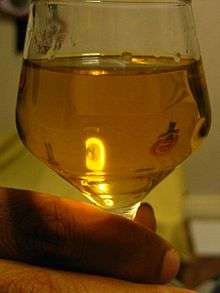
|
Aquavit Norwegian akevitt, a distilled beverage of about 40% alcohol, is distinguished from other aquavits originating in other Nordic countries and Germany because it's always made from potatoes, and aged in used sherry casks. Recipes remain secret, but most Norwegian aquavits are spiced with caraway and anise. There are at least 27 different Norwegian aquavits, suitable to different kinds of food, in drinks or as avec. Aquavit is especially popular with traditional food for Christmas. The classics are Lysholm Linie (a nice all-round aquavit to go with not too heavy food), Løiten Linie (with salted and smoked meat), Gammel Opland (all-round, especially good with traditional lutefisk) and Simers Taffel (to go with herring), you should also try Gilde Non Plus Ultra (as avec) if you enjoy the taste. The "Linie" aquavits have in fact travelled twice across the equator while ageing! |
Norway is often described as a "dry" country, because alcohol is highly priced and a glass of wine or beer in a restaurant costs at least 60 kr. When in cities and towns with many students such as Oslo, Bergen, Trondheim and Tromsø, you can very often find lower prices. Ask young people in the streets or at your place of accommodation for hints and tips of where to go. Beer can be bought at the supermarkets, however wine and stronger alcoholic beverages have to be purchased in state owned liquor stores (Vinmonopolet). The Vinmonopolet is a monopoly but maintains high quality and a wide selection of products; the finest products are moderately priced. The price of alcohol, however does not stop the locals from having a good time. They are often found drinking and carrying on in local street parties and on their porches.
The high prices is one reason why the tradition to hold vorspiel and nachspiel before going out is very popular in Norway. The words derives from German and can be translated into pre- and after party. If going out in the weekend, it is not unknown for Norwegians to gather at a friend's house and not leave for the nightclub until after midnight. So if you've seen Norwegian drinking culture abroad, and are shocked by the empty bar/club at 23:00, call your Norwegian friend and ask where the vorspiel is. (If that person is one of the many Swedes in Norway, vorspiel would mean foreplay – they would say foreparty.) It's likely to be a whole lot of fun. Clubs tend to fill up around the period immediately after midnight. However this is mostly true at weekends – during normal weekdays, you will often find Norwegians sitting in bars enjoying a couple of beers or a bottle of wine.
You must be at least 18 years old to purchase beer or wine and 20 years old to purchase spirits with an alcohol content of 22% and more in Norway.
Drinking in public is prohibited. This law is very strict, and even encompasses your own balcony, if other people can see you! Luckily, the law is very seldom enforced (cases of anyone being fined on their own balcony are very rare, for instance), and Norwegians do indeed drink in parks. There are calls for modifying the antiquated law, with debate in media: most people seem to agree that drinking in parks is alright as long as people have a good time and remain peaceful. However, if you bother others and get too intoxicated or a policeman happens to be in a bad mood, you may be asked to throw away your alcohol, and in a worst-case scenario, fined. Drinking openly in the street is probably still considered somewhat rude, and it would be more likely to attract police attention than a picnic in a park, and is advised against. Having a glass of wine in an establishment that legally serves alcohol at the pavement, of course, is not a problem.
Be careful about urinating in major cities like Oslo if you're drunk, fines for public urination can be as high as 10,000 kr! However, this normally isn't a problem if you urinate in a place where nobody sees, like a couple of yards into the woods. Public intoxication is also something you should be a bit careful with, especially in the capital, Oslo. In smaller towns the police will have no problem giving you a night in the local jail if they think you are disrupting peace and order.
In Norway, all alcohol with a volume percentage of under 4.75% can be sold at regular shops. This means you can get decent beer all over the place. The price varies, but imported beer is usually expensive (except Danish and Dutch beers brewed in Norway on licence like Heineken and Carlsberg). Shopping hours for beer are very strict: The sale stops at 20:00 every weekday, and at 18:00 every day before holidays (incl Sundays). Since the sale times are decided by the local council, it may vary, but these are the latest times decided by law. This means the beer will have to be paid for before this time. If it's not paid, the person behind the counter will take your beer, and tell you "Sorry pal, too late!". On Sunday, you can't buy takeaway alcohol anywhere.
For strong beer, wine and hard alcohol, you will have to find a Vinmonopolet branch. The state shop has a marvellous choice of drinks, but at mostly sky-high prices. The general rule is that table wines are more expensive than in nearly any other country. Expect 80–90 kr for a decent, "cheap" wine. However, as the taxation is based on the volume of alcohol per bottle rather than the wholesale cost, you can often find more exclusive wines at lower prices than in private establishments in other countries. Vinmonpolet is open until 17:00 Monday to Wednesday, 18:00 Thursday to Friday, and 15:00 on Saturday.
Many car borne visitors (and Norwegians on shopping trips to Sweden and Finland) bring alcohol into Norway, but mind the import restrictions; anything above the quota gives heavy duties.
Beers
The brands you are most likely to see in pubs are industrial lagers from Ringnes, Hansa, Borg, CB, Mack, Aass and Frydenlund (accompanied by a vast array of imported drinks). However, in the last ten years a range of microbreweries and craft breweries have made locally produced beer of all varieties and often high quality available. For instance Nøgne Ø, Ægir, Haandbryggeriet, Kinn, 7 Fjell and many more. Beer from small or specialty breweries are also available in pubs or cafes such as Mikrobryggeriet (Bogstadveien Oslo), Lorry's (Parkveien, Oslo), Grünerløkka Brygghus (Oslo) or Beer Palace (Aker Brygge, Oslo), Ægir (Flåm), UNA Bryggeri og Kjøkken (Bergen), Trondhjem Mikrobryggeri (Trondheim) and Christianssand Brygghus (Kristiansand). Norwegians are proud of their local breweries. At bars or pubs it is considered good manners to order a local beer first.
Non-alcoholic beverages
There are many manufacturers of local non-alcoholic beverages, such as fruit juices all over Norway. Norwegians drink coffee in large quantities. In the larger cities there are many coffee shops and patisseries which are also meeting places.
Water
Norwegian tap water is generally of high quality, clean and absolute drinkable. Tap water is mostley surface water, only a small proportion is obtained from sources underground. There are also bottled drinking water to buy, some added carbonic acid and/or different flavorings. Norwegian bottled water is of very high quality. Many Norwegians choose to drink water for the meals and bring drinking water when they go hiking.
Sleep
A single hotel room (always book ahead for weekdays) should cost you from around 800 kr and up (special offers are common, look for them), but you can find reasonable cheap lodgings in camping huts (300-600 kr, space for entire family), DNT mountain cabins (150-300 kr per person), youth hostels (150-250 kr per person), etc. Most of these will require you to make your own food, bring your own bedsheets, and wash before leaving.
A countryside cabin, hytte, is a prized family treasure. The high demand and the limits for exploitation pushed property prices through the roof during the first decade of the 2000s, and few foreigners can afford a cabin in Norway. As currency and prices are dependent on the oil price, the return on investment is very uncertain.
For longer stays (one week or more) consider renting an apartment, a house or a high quality cabin. Several agencies offer reservations on houses or cabins owned by farmers or other locals. This type of accommodation is frequently more interesting than a standard hotel.
Campsites for caravans, campers and tents are found in a large number in Norway. Many campsites also have small cabins for rent. The standard varies. Most campsites are only open during the summer months. In addition, there are a number of parking spaces separate for campers in cities.
Hotels in Norway are not cheap, but not so expensive that many expect, considering that Norway is a high-cost country, and there are several price ranges. Hotels are found, with some exceptions, in densely populated areas. Hotels called høyfjellshotell are often far into the mountain world.
Work
Citizens of countries belonging to the European Union, plus Iceland, Liechtenstein and Switzerland, do not require a permit and are free to live and work in Norway for up to 3 months (some restrictions apply for recent members of the European Union). In addition, citizens of a number of non-EU countries are permitted to work in Norway without the need to obtain a visa or any further authorisation for the period of their 90-day visa-free stay (for more information, see the 'Get in' section above).
You may start from the local office of the public agency NAV, to get legal advice and a list of available jobs. They also provide an online guide: Work in Norway. Even though the unemployment rate in Norway is very low (3.2% ), short-term employment may be hard to find. (Certainly when not fluent in a Scandinavian language.) If you decide to move there you have to fill in a "Residence Permit" which lasts for 3 years before it needs to be renewed.
Salaries ranged from 15,000 to 35,000 kr per month in 2012.
Stay safe
.jpg)
Norway has a very low rate of violent crime. The most likely crimes for tourists to experience is car break-ins and bicycle theft. Pickpockets do also tend to be an increasing problem in urban areas in the summer season, but it's still nothing like in larger cities in Europe. It is always a good idea to look after your belongings, this includes never leaving valuable objects visual in your car and locking your bike safely.
Single women should have no problems, although ordinary street sense is advised after dark.
Norway is one of the countries in the world with least corruption. Police and other authorities cannot be bribed, travellers are strongly advised against attempting in any form of bribery.
Norway has a unified police force ("politi"). The police force is the government authority in areas like crime, national security, major accidents, missing persons, traffic control, passports and immigration control. Most cities have municipal parking attendants, too, but the attendants do not have any authority beyond fining and removing vehicles.
Norway has a lot of electric vehicles, particularly in cities. These cars are very quiet and pedestrians should use their eyes, not ears, when crossing roads and streets.
Outdoor safety
The most unusual dangers to visitors are found in nature. Every year, quite a few tourists get hurt, even killed, in the mountains or on the seas, usually after given, unheeded warnings. For example, do not approach a glacier front, big waves on the coast, or a big waterfall unless you know what you're doing, and do not walk on glaciers without proper training and equipment.
When hiking or skiing, be prepared for a sudden shift in the weather, as these can happen very quickly in Norway. Carry the gear you might need to cope. If unsure about conditions, ask locals or go on a guided tour. For any written advice, make sure you understand how your experience might differ from that of the intended audience, and e.g. what is included in estimated hike durations. You are expected to manage on your own in the Norwegian wilderness, so you won't find fences or warning signs even at the most dangerous places.
Keep in mind that avalanches are common. Unless you know exactly what you're doing, stay in marked slopes when skiing. If you think you know what you're doing, think twice. 12 people were killed in avalanches just in the first three months of 2011 in Norway. For safety measures, see below.
Norway has few dangerous wild animals. Car crashes with the mighty moose or the smaller red deer account for the bulk of wild animal-related deaths and injuries. In some rural districts, sheep, goats, cows or reindeer can be seen walking or sleeping on the road.
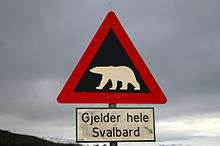
Specific rules and precautions apply to Svalbard, where you should never travel outside Longyearbyen without someone in your party carrying a weapon. The polar bears on Svalbard are a real and extremely dangerous threat for the unprepared, and there are cases involving death and/or injury almost every year. There are more polar bears here than humans. Svalbard is a fragile, dry arctic tundra with large parts almost untouched by humans. The current recommendation is that non-local visitors participate on organized tour arrangements only. Breaking the law, disturbing wildlife or being reckless can land you a fine and/or deportation from the archipelago. That said, if you come well prepared with common sense, the visit will be one of the most memorable you've ever had. The nature, scenery and history of Svalbard is simply breathtaking.
As for other wild animals on mainland Norway, there are not much more than a few extremely rare encounters with brown bear and wolf in the wilderness. Contrary to popular belief abroad, there are no polar bears in mainland Norway, let alone polar bears walking city streets. The Scandinavian brown bear is peaceful and will generally run away from humans. In any case it is extremely unlikely that tourists will even see a glimpse of one of the around 50 brown bears remaining in Norway. Norwegian wolves are not dangerous to humans. In general, there is no reason worry about dangerous encounters with wild beasts in Norway.
At sea
Norway's immense coastline is an adventure for visitors, but also a treacherous area. Huge waves that build up power across the Atlantic crush on slippery rocks and slabs along the outer coast. Every year tourists are in serious danger and occasionally even killed when they challenge the big waves along the shores. Many tourists also leave the sheltered waters and venture onto the open sea in small boats, every year tourists are rescued at sea, some even perish. Note that life jackets are required in small boats.
Norway has many ferry crossings and other vessels must yield to ferries. Dont go out in kayak or dive near the docks and routes of car ferries. Sail boats and small boats must also yield to larger vessels and cargo ships.
Skiing in the mountains
To go hiking and skiing in the mountains during winter requires precautions. Snow storms and avalanches are dangerous, occurs overwhelmingly and require safety measures. Therefore The Norwegian Trekking Association compiled The Norwegian Mountain Code (Fjellvettreglene), safety rules that significantly reduce the danger.
Glaciers
Glaciers are one of the most dangerous places for visitors to the Norwegian outdoor. Never underestimate the power of the glacier. Observe warning signs. Never approach the front of the glacier. A glacier is not a stable piece of ice, it is constantly moving and huge chunks regularly fall off.
Do not enter a glacier without proper equipment and a skilled local guide. Sunrays get reflected from the white snow, so it necessary to use sunscreen to protect your skin. Bring warm clothes for tours on the glacier.
On the road
- For more information on driving in winter conditions, see the Winter driving article.
If you plan to cross the mountains by car (for instance by driving from Oslo to Bergen) in the winter season, it is imperative that you are prepared for the journey. The conditions are harsh. Always keep a full tank of fuel, and keep warm clothes, food and drink in the car. Make sure your tires are good enough and suited for winter conditions (studded or non-studded winter tires, "all-year" tires are not enough), and that you have the sufficient skills for driving in snowy and cold conditions. Roads are often closed on short notice due to weather conditions. For advice on conditions and closed roads, call 175 in Norway or check the online road reports (in Norwegian only) from the Norwegian State road authorities. Remember that not all parts of the roads have cellular phone coverage.
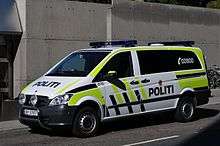
☎ Emergency numbers
.jpg)


- If you are unsure which number to call, ☎ 112 is the central for all surch and rescue services and will put you in contact with the correct department.
- For non-emergencies, the police is to be called on ☎ 02800.
- For treatment of casualties or serious illness (non-emergencies) call ☎ 116117.
- The hearing impaired using a text telephone can reach the emergency services by dialing ☎ [tel:1412 1412}.
- Roadside assistance is provided by Falck (☎ 02222) and Viking (☎ 06000). AAA members may call NAF on ☎ 08505. In case of traffic accident you are supposed to call the police only if individuals are injured or if the crash causes a traffic jam. The police will not get involved if there are damages on the vehicles only.
Stay healthy
- The water quality in Norway is mostly adequate and tap water is always drinkable (except on boats, trains etc.).
- The hygiene in public kitchens is very good, and food poisoning rarely happens to tourists.
- Norway can get relatively warm in the summer, but be prepared to bring warm clothes (sweater, windbreaking/waterproof jacket), as they might come in handy. It's hard to predict the weather, and in summer, you may experience severe weather changes during your stay.
- Tourists hiking in the high mountains (above the forest) should bring sports wear for temperatures down to freezing (0 °C) also in summer.
- Norway has a high density of pharmacies. Nose sprays and standard pain killers (paracetamol, aspirin) can also be purchased in grocery stores and gas stations.
- Do not underestimate the power of the Nordic sun! The sun is generally not as strong as in southern Europe, but the air is often very clear and clean in the North and UV-levels can be quite high despite the low sun, especially in the high mountains. This sometimes applies also in cloudy weather. Snow fields and water surfaces multiplies the radiation. And in cool conditions (low temperatures or wind) you don't feel that the sun burns your skin. Bring sunglasses when you go to the high mountains, when you go skiing in spring and when you go to the beach.
- In southern Norway there are ticks (flått) in summertime. They can transmit Lyme's disease (borreliosis) and more serious TBE (tick-borne encephalitis) through a bite. The risk areas for TBE are mainly along the coast from Oslo to Trondheim. Although incidents are relatively rare and not all ticks carry diseases, it's advisable to wear long trousers rather than shorts if you plan to walk through dense or tall grass areas (the usual habitat for ticks). You can buy special tick tweezers from the pharmacy that can be used to remove a tick safely if you happen to get bitten. You should remove the tick from your skin as quickly as possible and preferably with the tick tweezers to reduce the risks of getting an infection. If the tick bite starts to form red rings on the skin around it or if you experience other symptoms relating to the bite, you should go visit a doctor as soon as possible. Since ticks are black, they are more easily found if you wear bright clothes.
- There is only one type of venomous snake in Norway: the European adder (hoggorm), which has a distinct zig-zag pattern on its back. The snake is not very common, but lives all over Norway up to the Arctic circle (except for the highest mountains and areas with little sunshine). Although its bite hardly ever is life-threatening (except to small children and allergic people), be careful in the summertime especially when walking in the forests or on open fields. If you are bitten by a snake, seek medical assistance. The probability of being bitten is however very small, as the adder is very shy of humans.
Contact For minor injuries and illness, go to the local "Legevakt" (emergency room/physician seeing patients without appointment) ☎ 116 117. In cities this is typically a municipal service centrally located, be prepared to wait for several hours. In rural districts you typically have to contact the "district physician" on duty. For inquiries about toxins (from mushrooms, plants, medicin or other chemicals) call the national Toxin Information Office at ☎ +47 22 59 13 00
Respect
Norwegians are generally open-minded and tolerant and there are few, if any, dos and don'ts that foreign visitors need to keep in mind. If anything, it is important to keep in mind that Norway is perhaps the most egalitarian country in the world. Behaving in a way that suggest either party is inferior or superior is considered exceptionally rude, and the flaunting of wealth or rank (if any) is frowned upon. Most Norwegians will handle misunderstandings or possibly offensive comments in a friendly manner and almost all will respond well to compliments paid to the country in general.
Many Norwegian people can however be mistaken as somewhat rude and unwelcoming, because they can be very direct and that small talk generally doesn't come easy. This is just a matter of culture; making contact with strangers, such as talking with fellow passengers on the bus, is uncommon. This does not apply to train journeys, or outside the bigger cities where small talk will be made upon the base of curiosity. During hikes in remote wilderness, talking to strangers on the same trail is customary.
Furthermore, Norwegian as a language is very straightforward. The once common use of the polite pronoun is nowadays extremely rare, and so are polite phrases and words in everyday situations, so don't be offended if a Norwegian speaking a foreign language uses a very familiar language. The use of informal language also applies when shopping, checking in at hotels and similar, but do not expect small talk in those situations either. Norwegian does not have something corresponding directly to please (German bitte), some may say unnskyld (excuse me) to call your attention. On the other hand, expressing thanks is important in Norway, this occurs in many situations. For instance after being served food in a private home it is customary to say thanks for the meal (takk for maten), at more formal occasions the "thanks" is often accompanied by a handshake. For instance after a eating or travelling together some Norwegians says thanks for good company. Many Norwegians also express a thanks for last time we met for instance a few days after meeting a party.
The Norwegian culture in general is very informal and Norwegians usually address each other's by first name only, except perhaps in official meetings. The informal culture is not equivalent of that in southern parts of Europe; showing up late for meetings is considered rude, so is talking loud, being too personal with strangers and losing your temper. It is customary to take off your shoes when entering a Norwegian home, in winter this is often a necessity.
Norwegians' reputation for being cold and unwelcoming may be a result of a surprisingly complex unwritten code of conduct with many apparent contradictions. For example; while it is very uncommon to make contact with strangers at public transportation like buses, the opposite is true when you meet Norwegians in outdoor activities like hiking or skiing: Greeting a fellow hiker or skier is expected, not doing so is often considered quite rude. Another phenomena that often confuse foreigners is the role of alcohol in social interactions. It is best explained as the grease that enables Norwegians to meet and make contact without too much friction, again with exceptions. Fortunately, tourists are exempted from most or all social norms, and Norwegians are in general quite aware, and humorous, about the contradictions in their social norms.
It is increasingly popular among visitors to build stone cairns in wildnerness, along rocky beaches and on mountain passes. Stone cairns are used to mark trails and can in fact be misleading to hikers. Visitors building cairns often pick stones from stone fences, some are actually cultural heritage, some are in use for reindeer, sheep or cows. It is in fact illegal to alter nature like this, even if only with a simple boulder.
The 22 July 2011 terroist attack is a national trauma, only surpassed by the second world war. The event is a sensitive issue in public and visitors are adviced to approach the topic carefully. Utøya island is not open to general visitors. The site of the bomb is in the middle of Oslo and can be visited by anyone.
Patriotism

Norwegians can also be perceived as somewhat nationalistic. It is common to use the flag in private celebrations (such as anniversaries and weddings), and many will also fly the flag on public holidays. Most Norwegians will speak warmly of their country, in particular about subjects such as nature and the country's economic success. May 17, the constitution day, can perhaps be a bit overwhelming for foreigners, as the country is covered in flags, citizens dress up in their finest clothes and celebrate all day long. Norwegian nationalism is however generally an expression of appreciation of living in a successful community, not aggressive in any way. On constitution day, dress up and try to say gratulerer med dagen (literally "congratulations on the day") to anyone you meet, and you will probably get the same in response and see a lot of smiles, even if you're not Norwegian at all. Norwegians take pride in the fact that the parades on constitution day are made up of school children and families instead of military troops. May 17 is a celebration of the 1814 constitution that established Norway as a liberal democracy, the constitution is still in effect.
Norway has a friendly rivalry with its neighbours, especially Sweden, whose inhabitants are the butt of many jokes. Comments about Norway's superiority are much appreciated.
Cope
First time visitors not familiar with the country tend to plan a trip in Norway from city to city. Although Norway has many nice cities the country's main attraction is the land itself, the nature, the landscapes, the wilderness, as well as a number of man-made sights in rural districts, notably road constructions and cultural treasures such as the stave churches. Unlike many other countries in Europe, a trip to Norway should ideally be planned according to types of landscapes to visit as well as a selection of cities. Norway is a long country with long distances and complex topography, and travellers should not underestimate distances.
Numbers, time and dates
Norwegians use a comma as the decimal separation sign or radix. For instance, "12,000" means 12 (specified with three decimal places) not 12 thousand, whereas "12 000" or "12.000" means 12 thousand.
Like many countries, Norwegians typically use the 12 hour clock system in speech and the 24 hour clock system in writing, print, signs and timetables. Norwegians don't use pm/am to indicate morning or afternoon. In Norwegian "half ten" ("halv ti") means half past nine, when speaking to a person not fluent in English better not use this form to avoid misunderstanding.
Dates can be seen abbreviated in a number of ways, but the order is always DAY-MONTH-YEAR, for instance 12.7.17 or 12.07.17 is always 12 July 2017 (120717 and 12/7-17 are also common, but regarded as incorrect forms). Monday is considered the first day of the week, while Sunday is the last. In timetables, weekdays are thus often indicated by numbers 1 (Mon) through 7 (Sun). Norwegian calendars will also indicate the number of the week 1 through 53. Timetables for public transport often use the abbreviation Dx67, meaning "daily except Saturday and Sunday".
Norway uses the metric system only. A Norwegian mile, 'mil', is equal to 10 km. There is virtually no knowledge of Imperial or US measures. Few Norwegians will be able to convert from Celsius (Centigrade) to Fahrenheit, and weather forecasts use metric units. However, many modern cell-phones have conversion programmes which can be used to understand the metric system.
In Norwegian there is usually no concept of ground floor as in the UK (or "Erdgeschoss" in German), instead the entrance level of a building is called the first floor ("første etasje" or labelled zero, 0) like in the US. Levels are then counted 1, 2, 3 etc.
House purchase
If purchasing a house and business in Norway do check all legal documents (kjøpekontrakt/takst) and maps (grensekart) are correct. Ask for information in the native language you are used to. Make sure the Estate Agent is registered with NEF.
Connect
Mobile phone coverage is universal in urban areas and generally also good in rural Norway, though on occasion some rural valley areas might be badly covered.
Even in the most remote mountain cabins, as long as they are staffed, you will usually be able to send a postcard.
Internet
Most Norwegian households are connected to the Internet in some way (often broadband), making cybercafés hard to find outside major cities, due to relatively low demand. Most public libraries have free public access to the internet, but a limited number of computers and limited opening hours.
If you bring a laptop with a wireless connection you will find wireless internet zones just about everywhere (gas stations, grocery stores, city centres, cafés, shopping centres, hotels, etc.) Be prepared to pay for it though. It is not unusual for hotels to have a terminal for guest use. Around 60% of camp grounds have Wi-Fi Internet, but if it's crucial for you, best to ask before paying for your camping space.
Telenor (national telecoms provider) sells pre-paid SIM cards for 49 kr, providing fast 4G internet access capped at 10 kr per day. Speed is reduced after 500MB in a month, unless you purchase a further data package (another 49 kr/500MB.Telenor stores (including the one at the airport) ask 199 kr for this SIM card, however you can purchase it in convenience stores for 49 kr. Activation on-line requires a Norweigan ID, however Telenor stores can do this instantly for free for foreigners on presentation of your passport. (Prices as of May 2014.)
As of August 2011, Telenor (national telecoms provider) sells prepaid wireless 3G internet dongles for computers (700 kr), 150 kr buy-in must be purchased with the dongle itself, that comes with 50 kr credit and 300MB of data to be used in 4 days. Then, another 150 kr purchase must be made for 15 days unlimited internet access. 3G speeds are very usable, and if 3G service is not available the dongle steps down to 2G (not so much fun). Of course, these prices and conditions may change quickly. There is a mobile phone shop at Oslo airport (landside) that sells phone equipment.
There are other providers; NetCom (part of the TeliaSonera group) offers coverage that is slightly less than Telenor but prices are better; 150 kr gets you a data-only SIM with 1GB data at 4G speeds for a week, 29 kr gets you 500MB for a day, or 200 kr for 2GB/2 weeks or 300 kr for 4GB/month. With voice the packages are 1GB+talk/text for 199 kr, 3GB+talk/text for 299kr, and 6GB+talk/text for 399 kr.
Radio
For foreigners used to listening to FM radio, Norway is becoming a challenge. During 2017 the major FM network were closing down and the larger radio stations are only transmitted via internet, cable network or DAB + (Digital audio broadcasting). Most Norwegian rental cars do have a DAB + car radio, though. There are around 30 national DAB + stations, broadcasting music to suit all tastes. Around half of them are provided by the public broadcaster NRK, the rest are commercially funded. Local radio stations still broadcast on FM, but they have limited range and will quickly disappear when driving outside urban areas. FM and DAB + broadcasts are in Norwegian only. The only exceptions are NRK's news station Alltid Nyheter which rebroadcasts BBC World Service in English at night as well as some programmes and reports from Swedish Radio, and NRK Sápmi which broadcasts in Sami.
